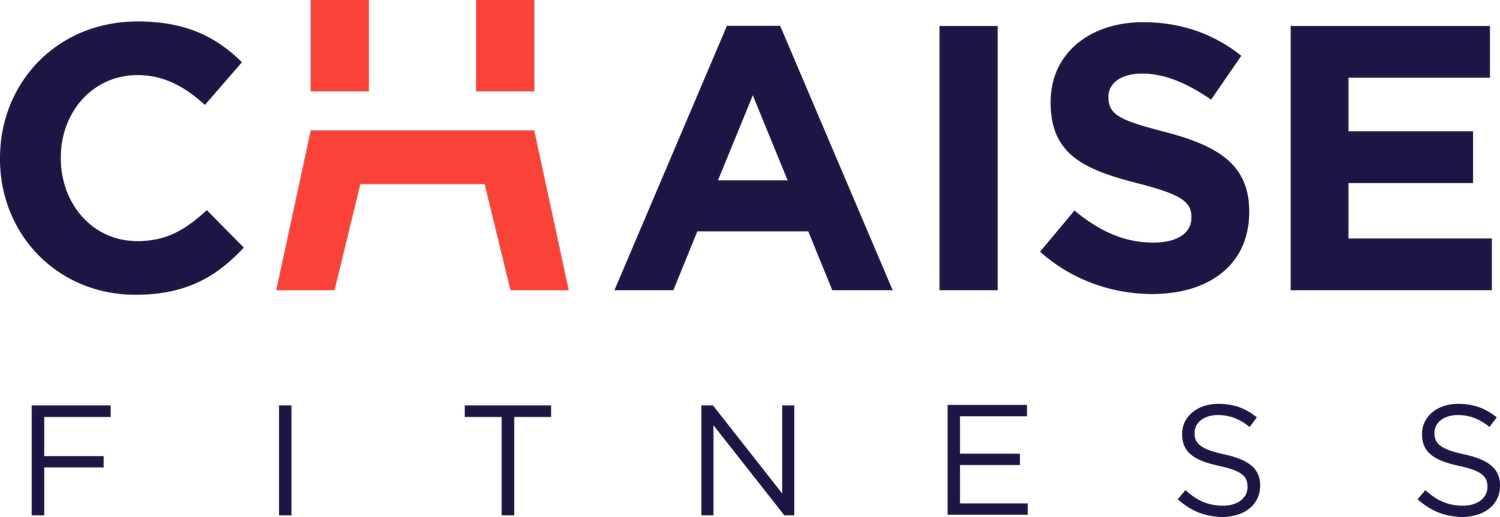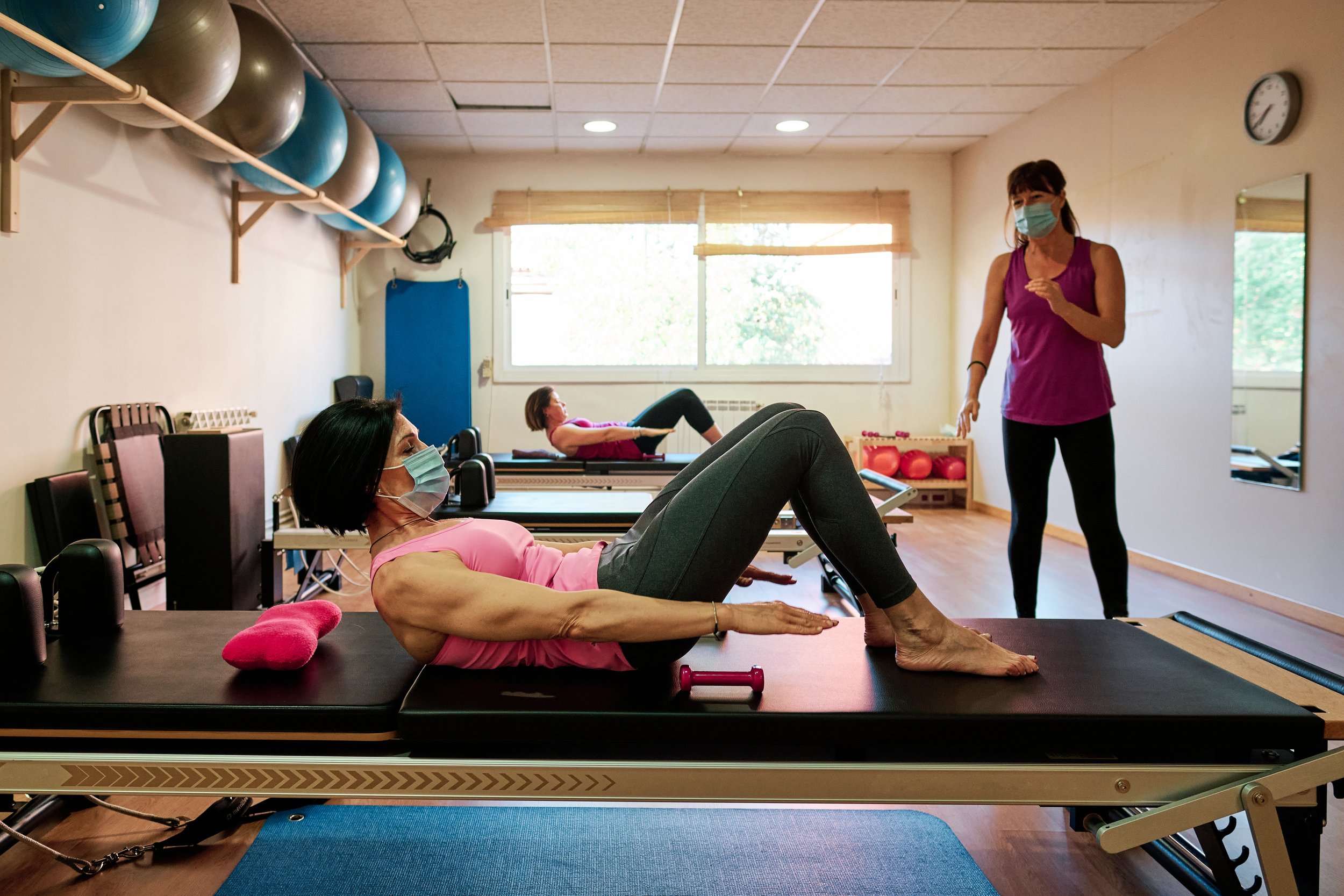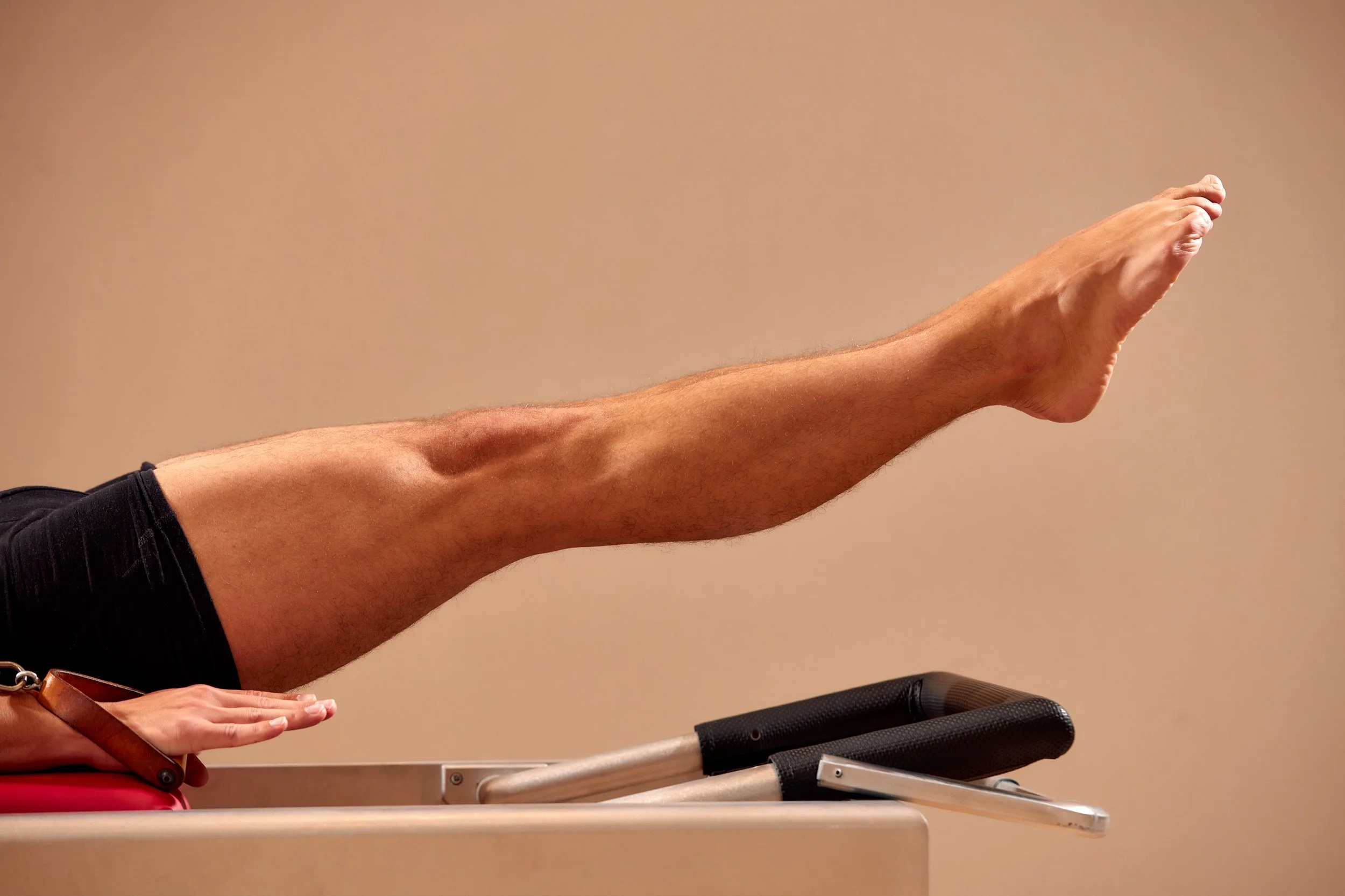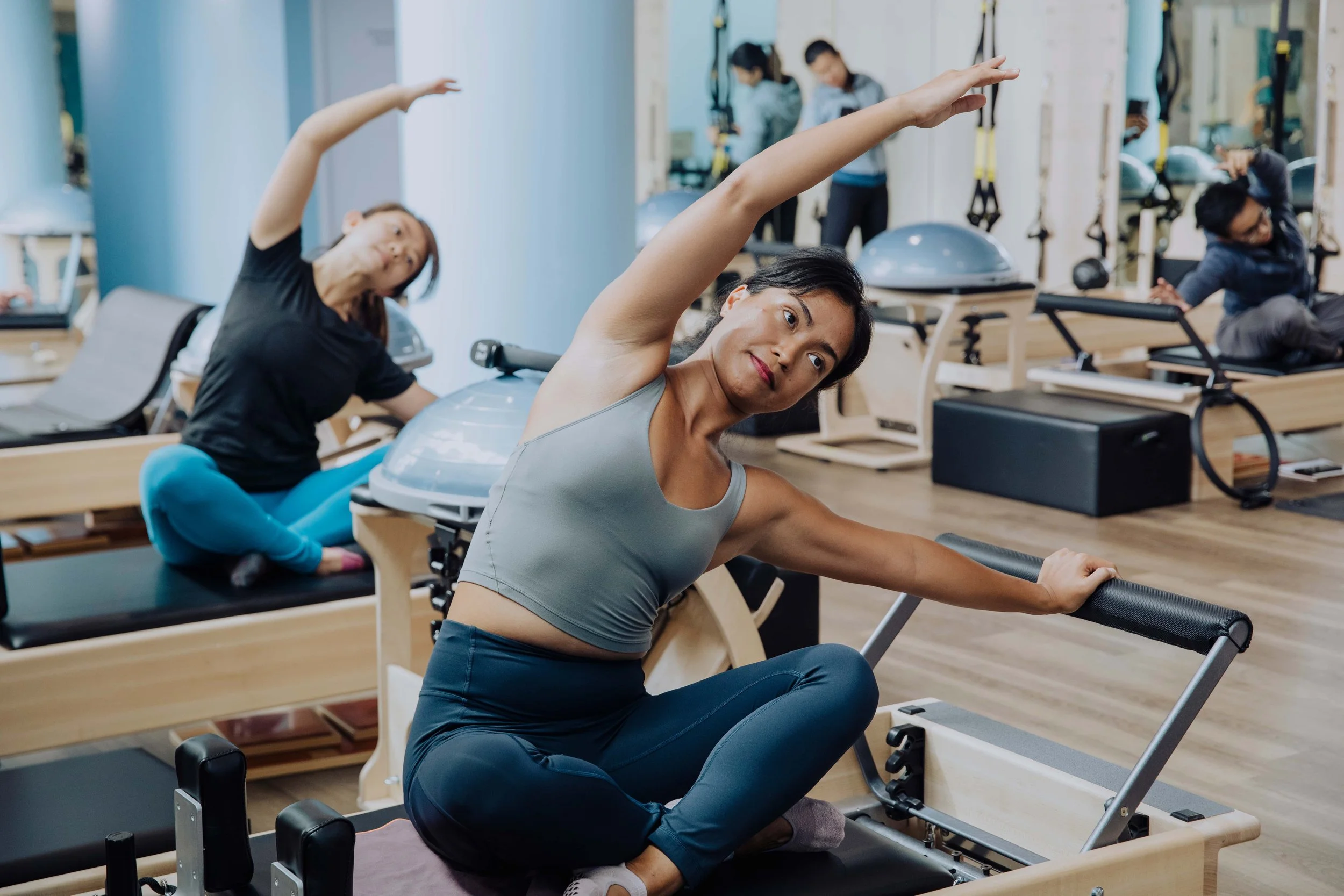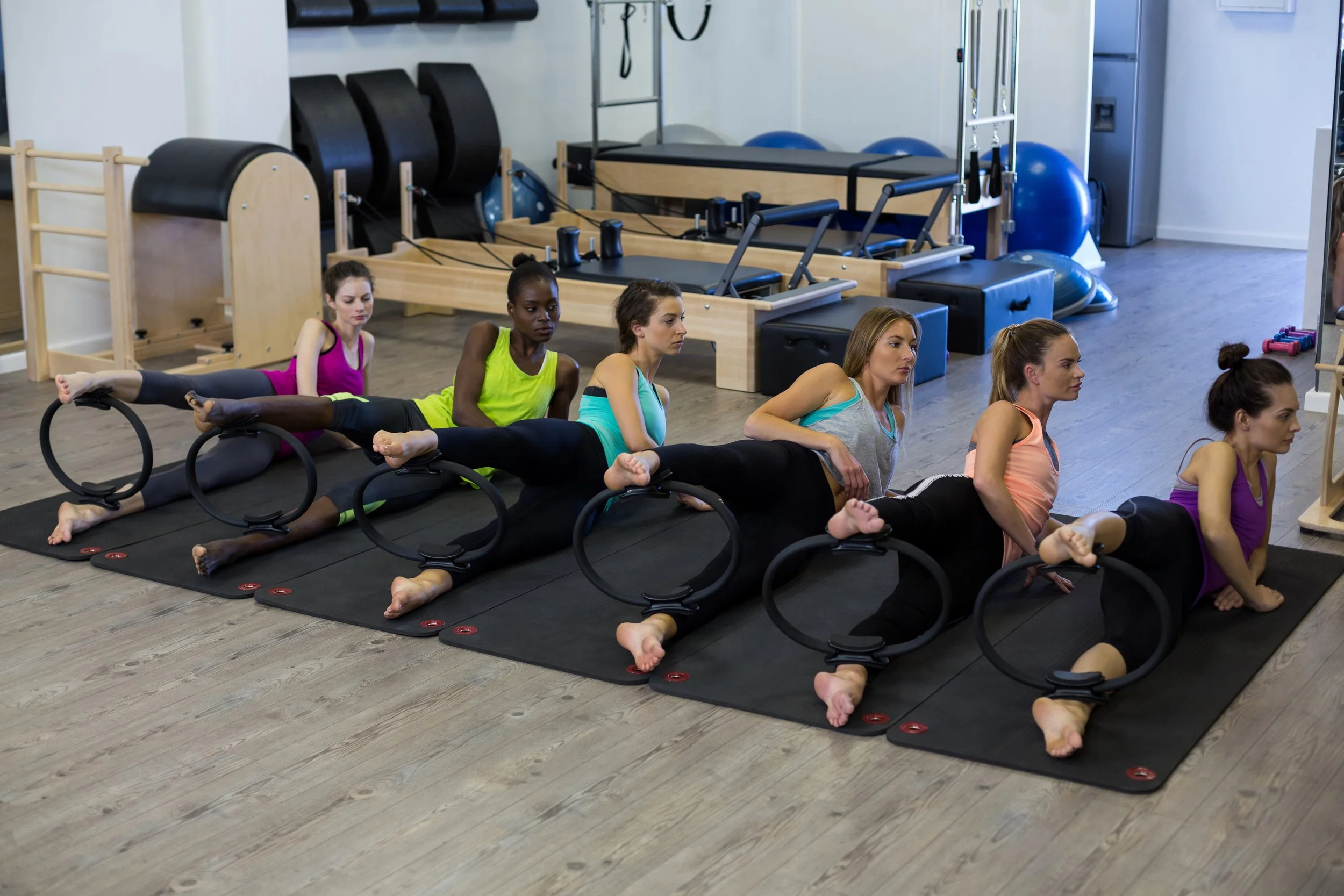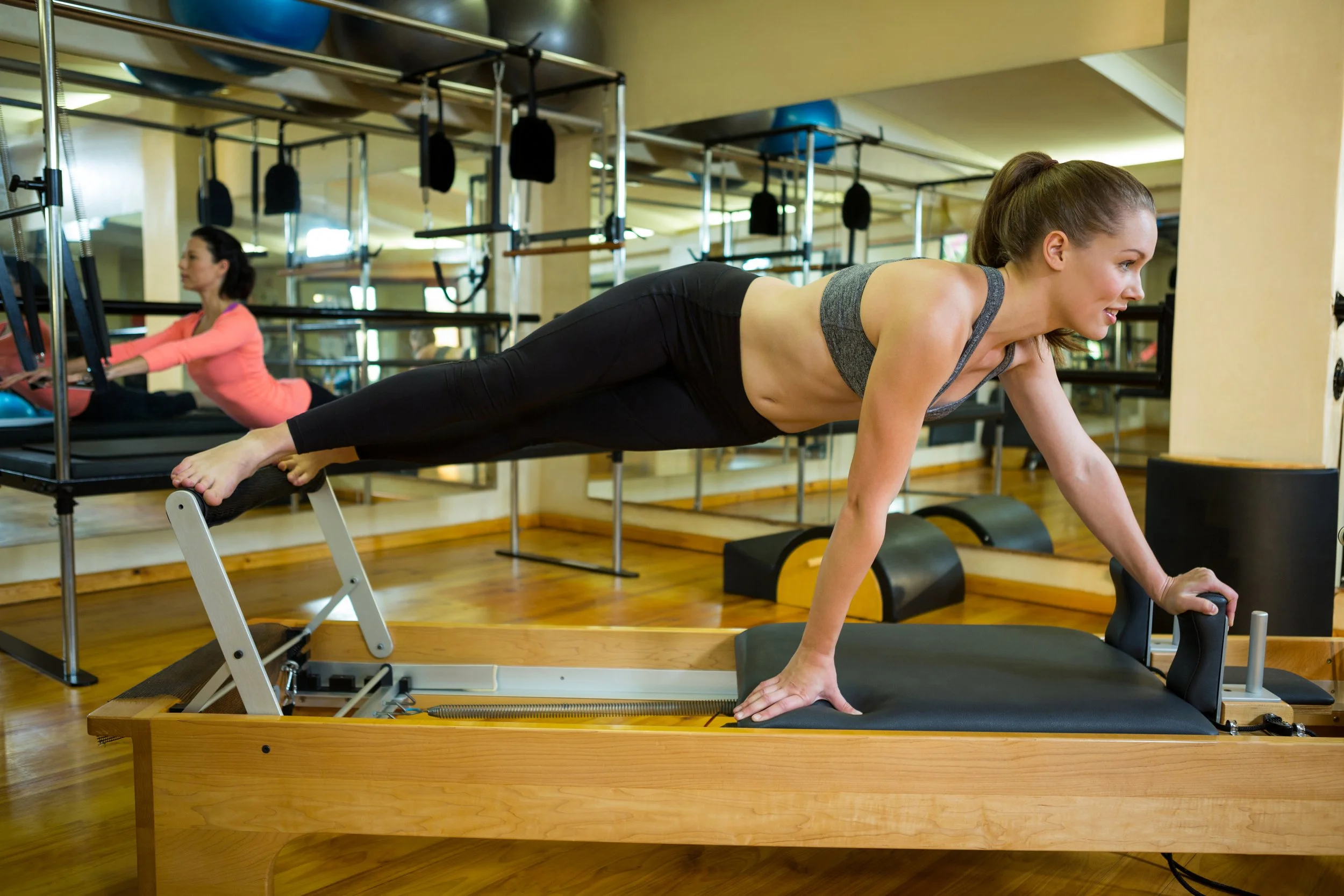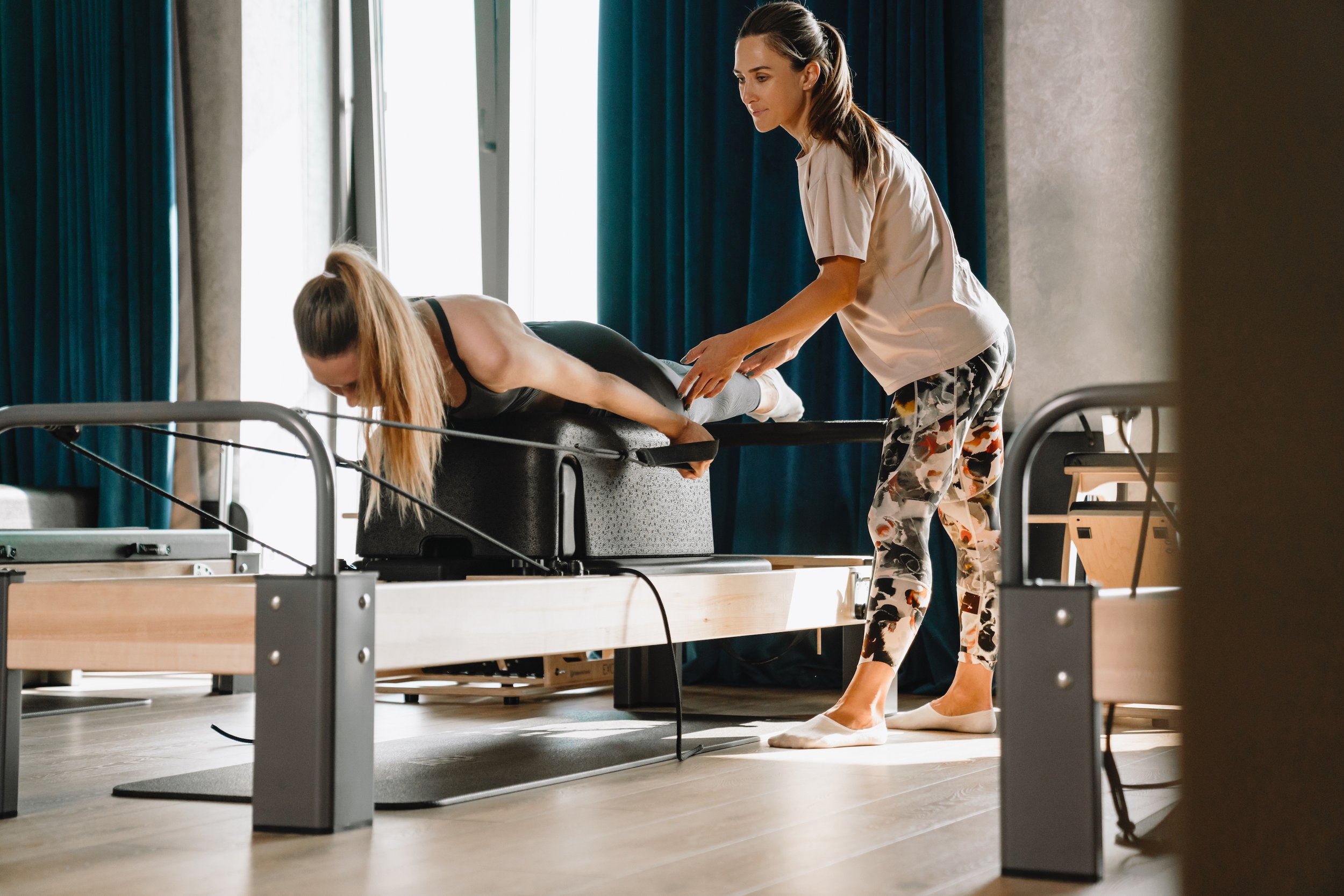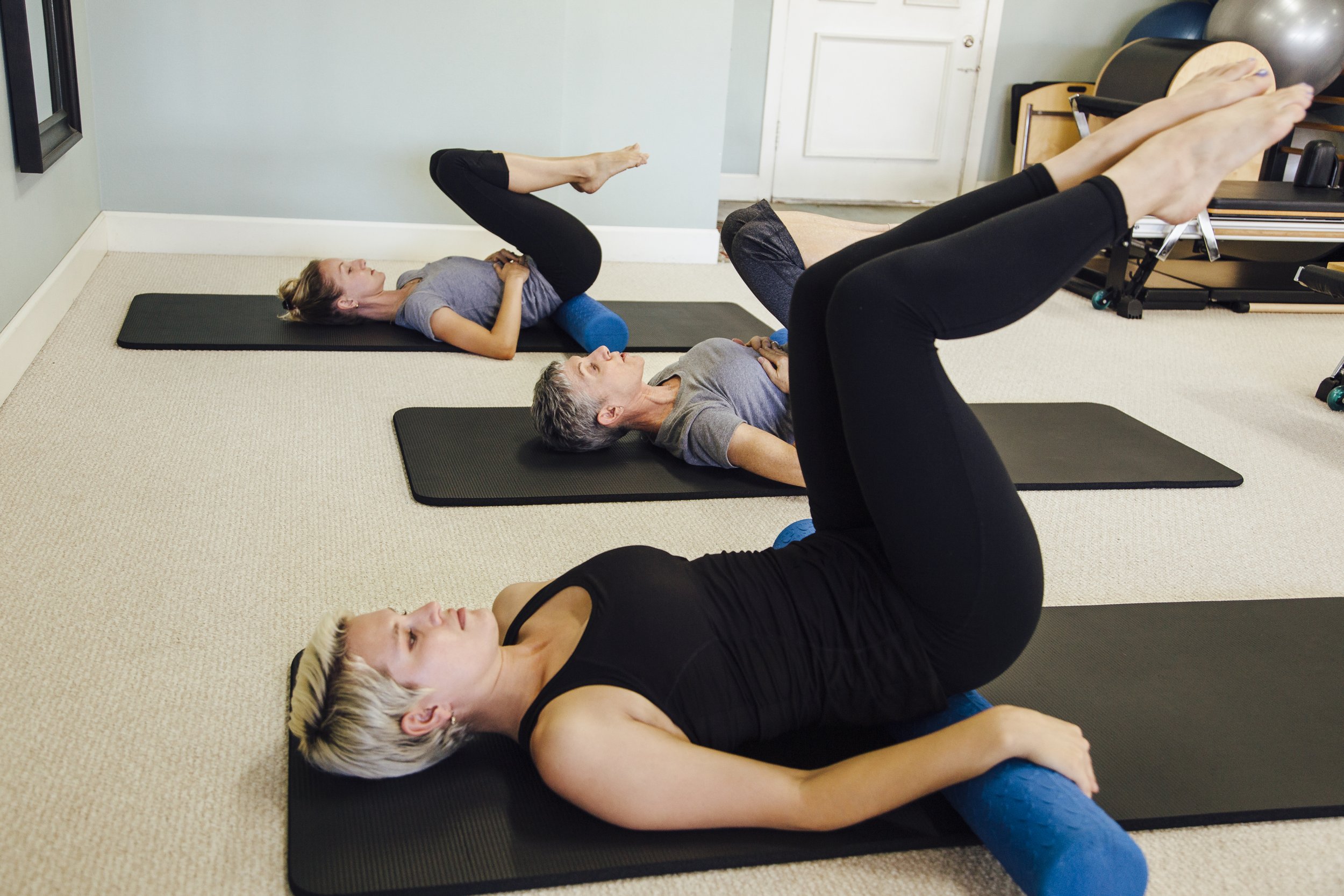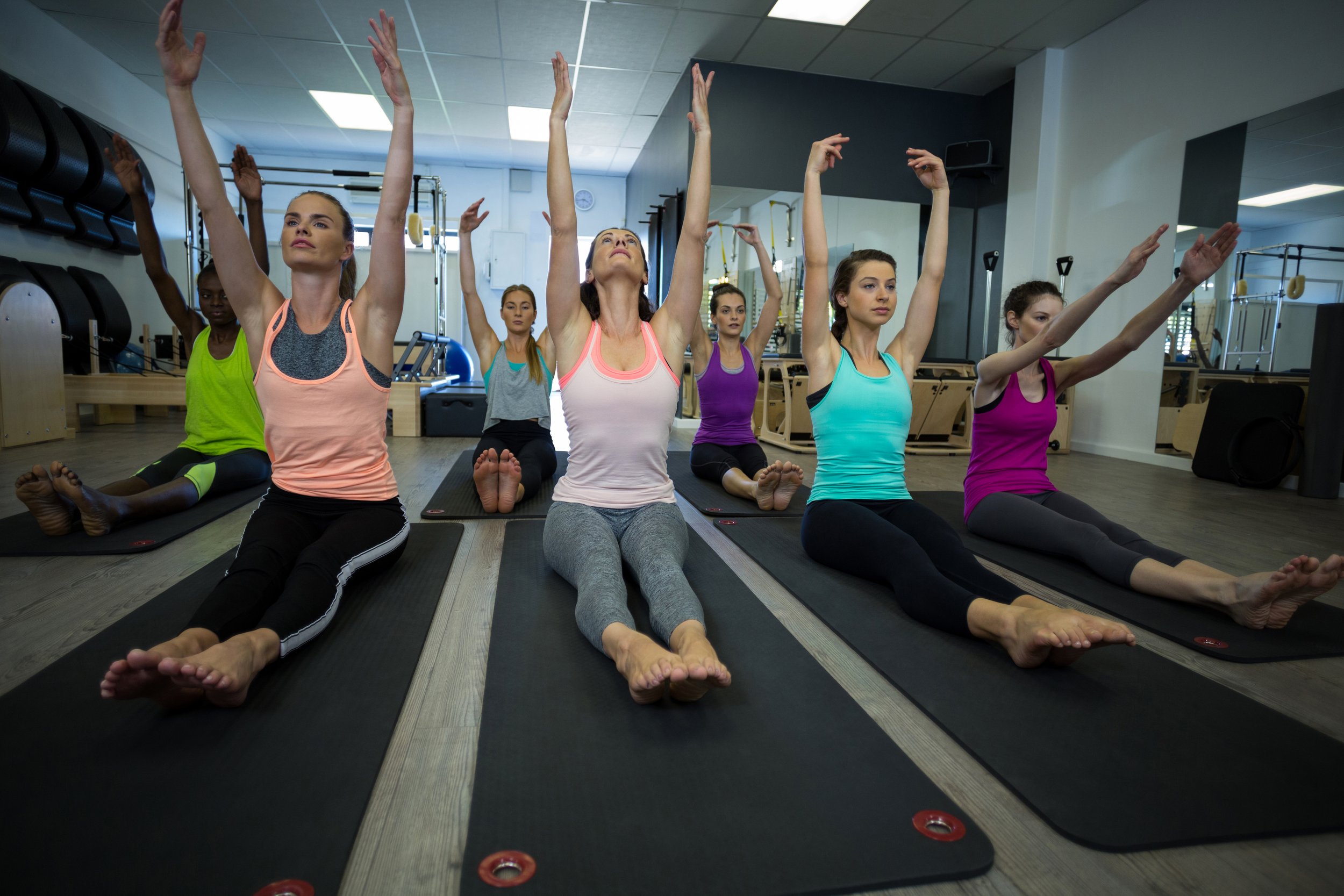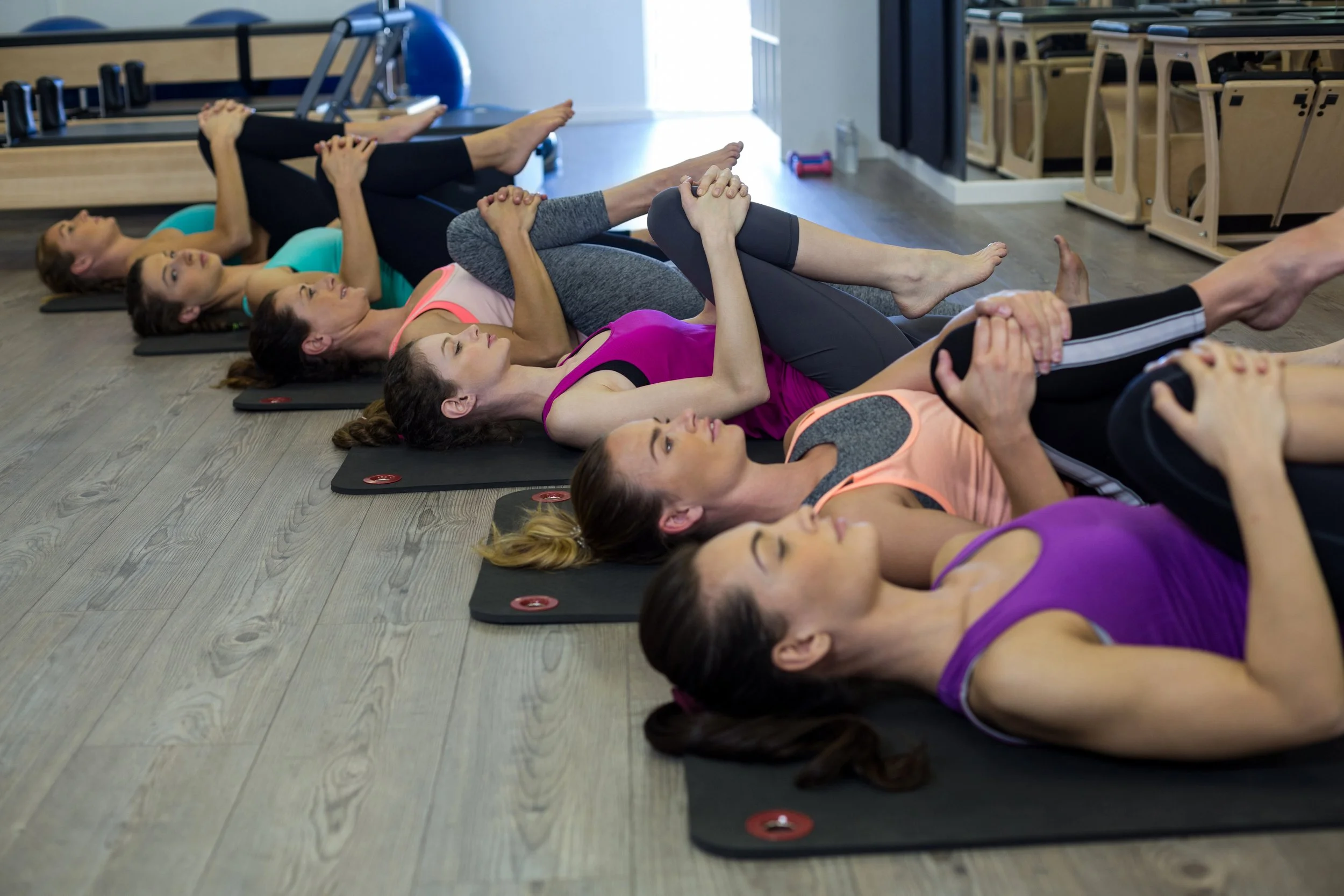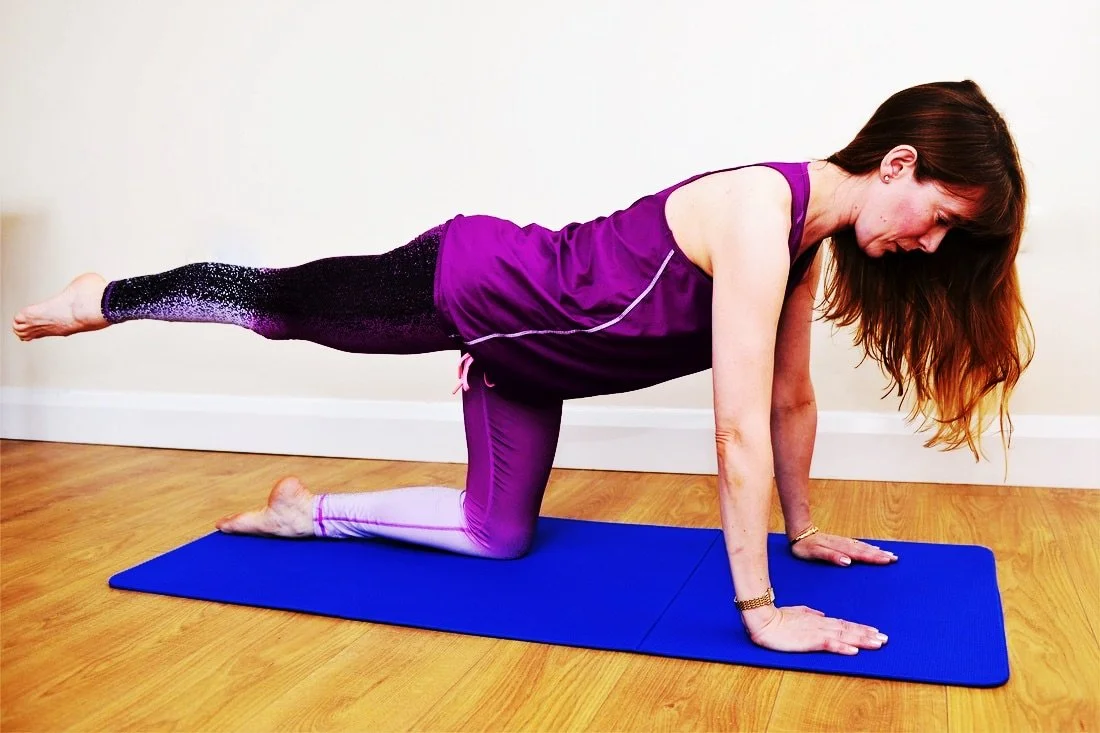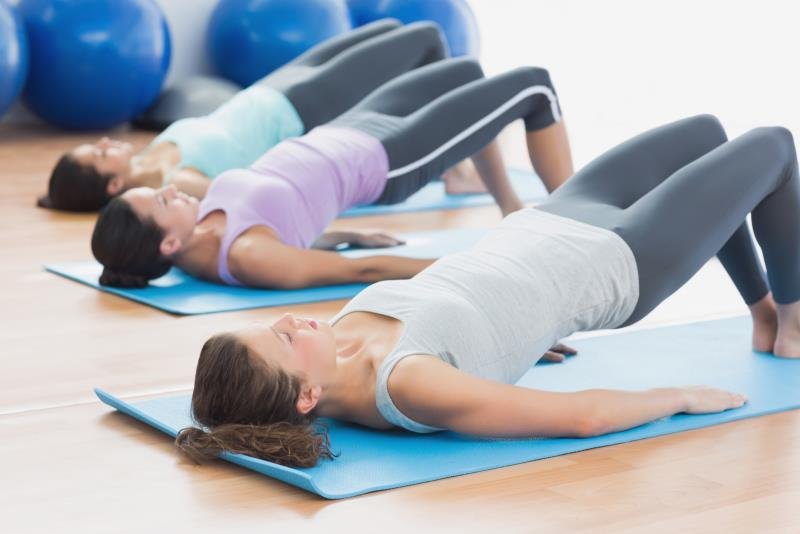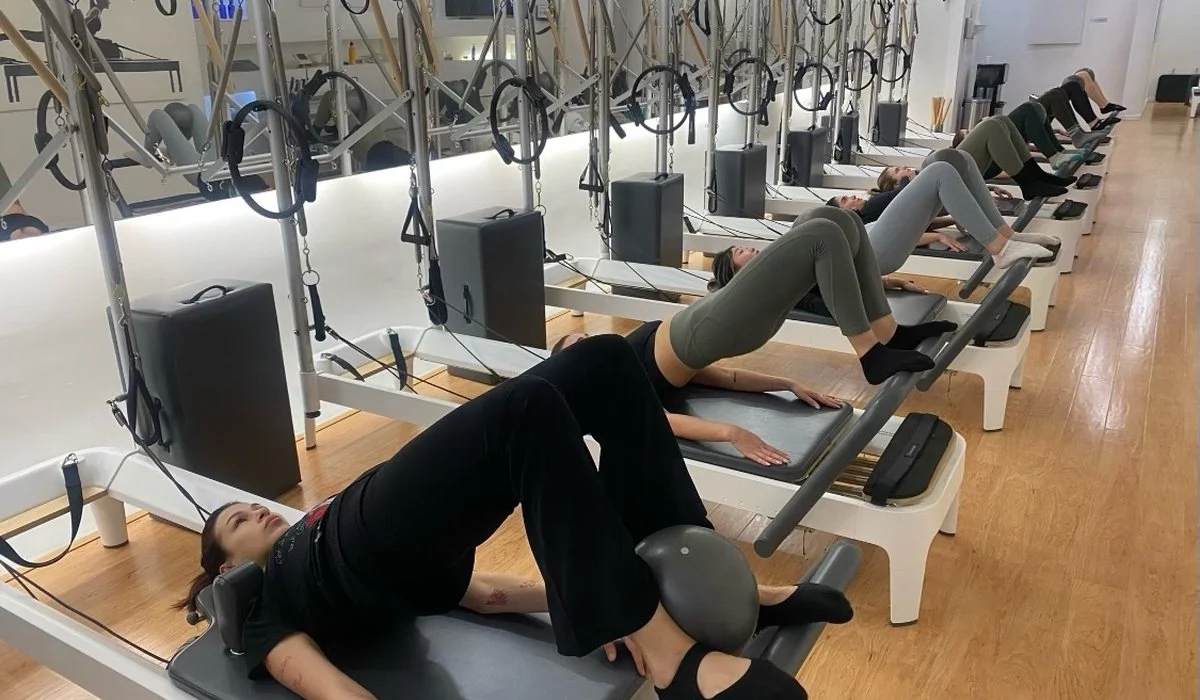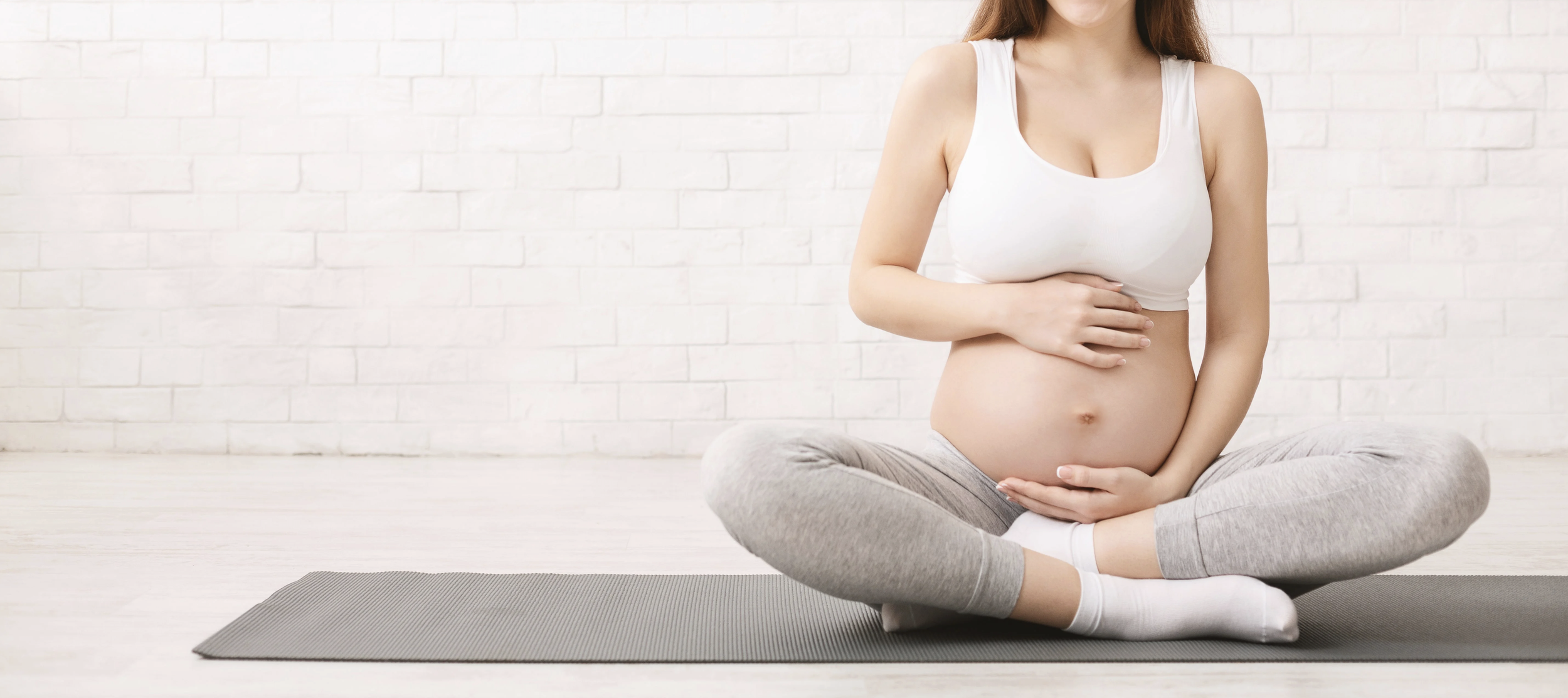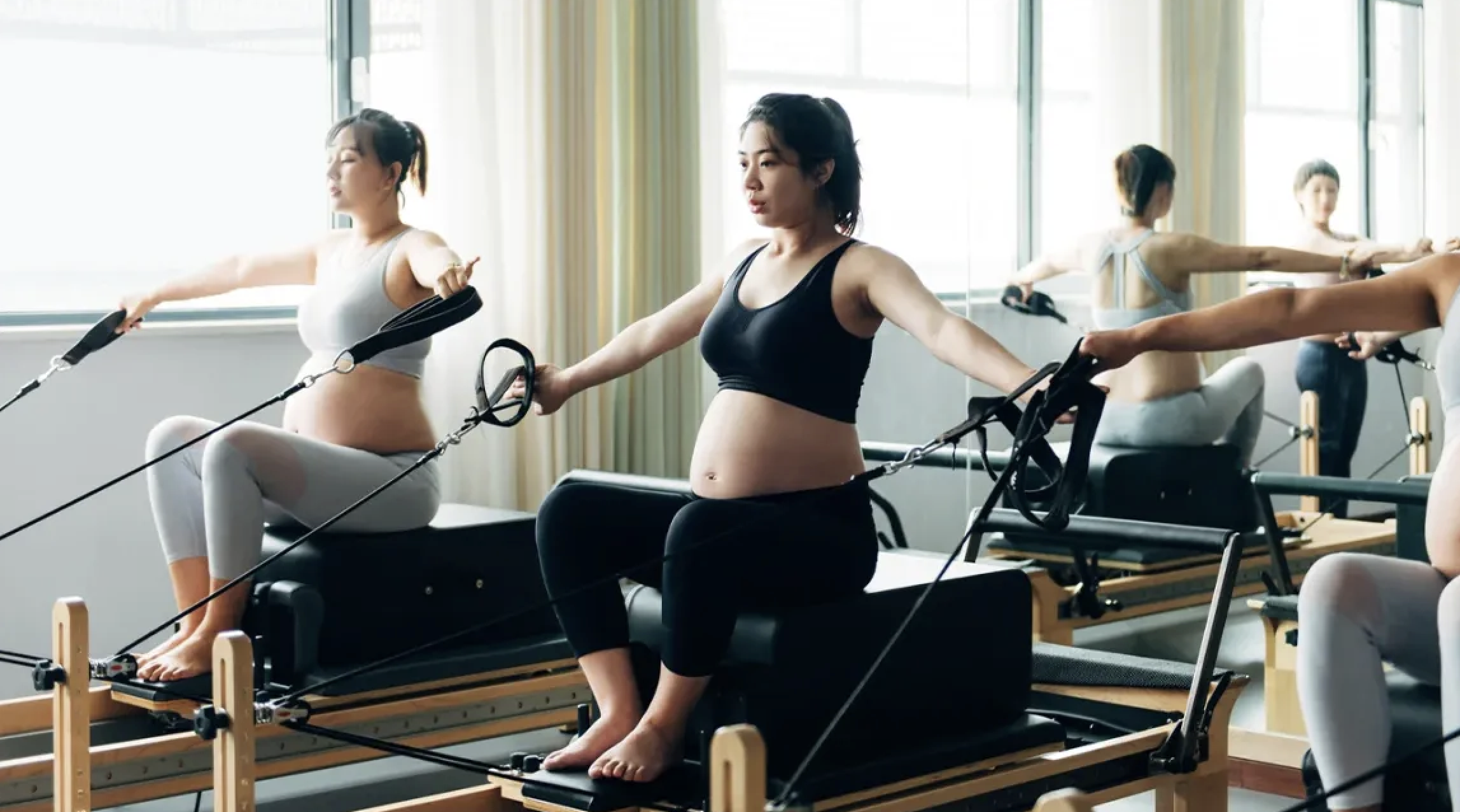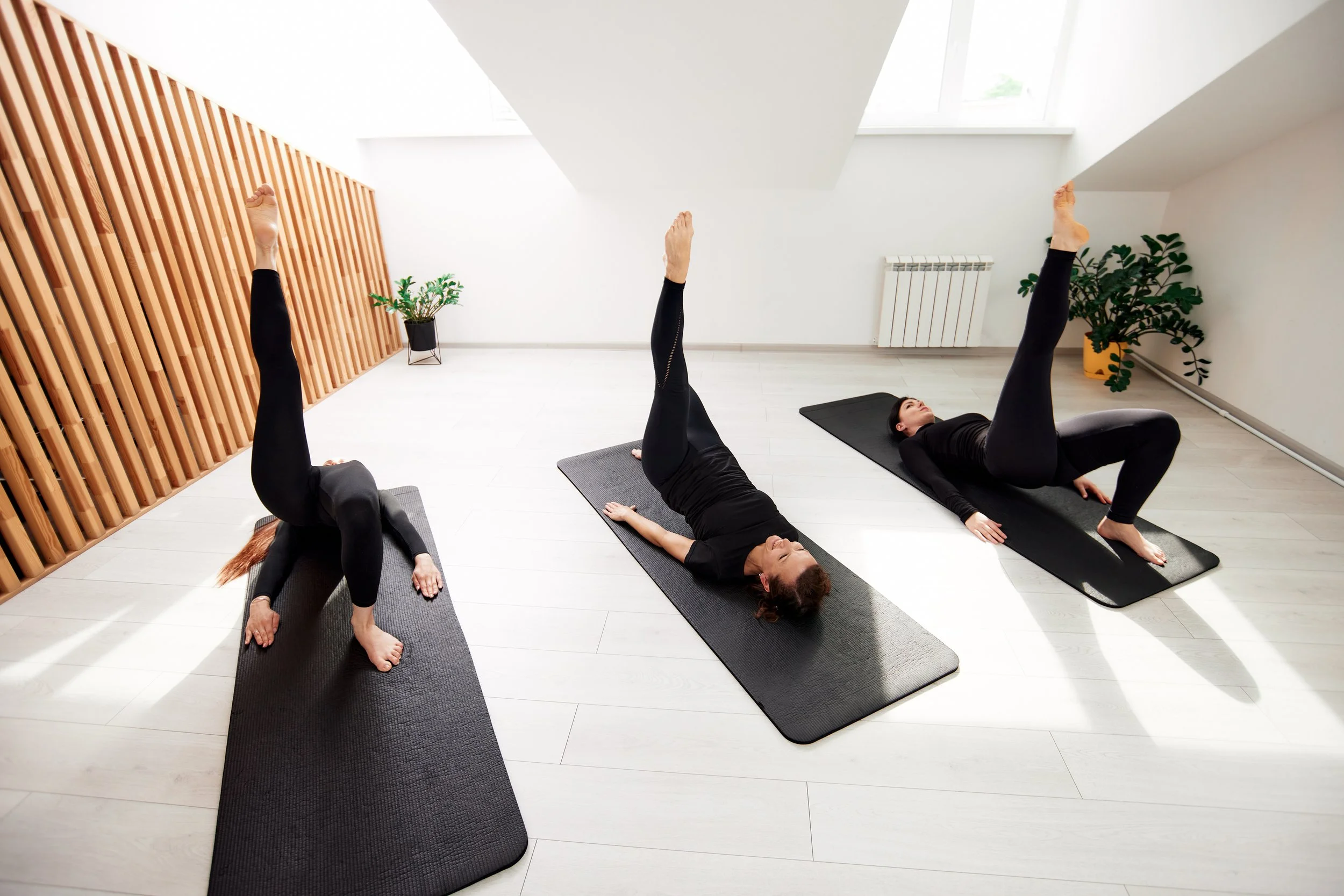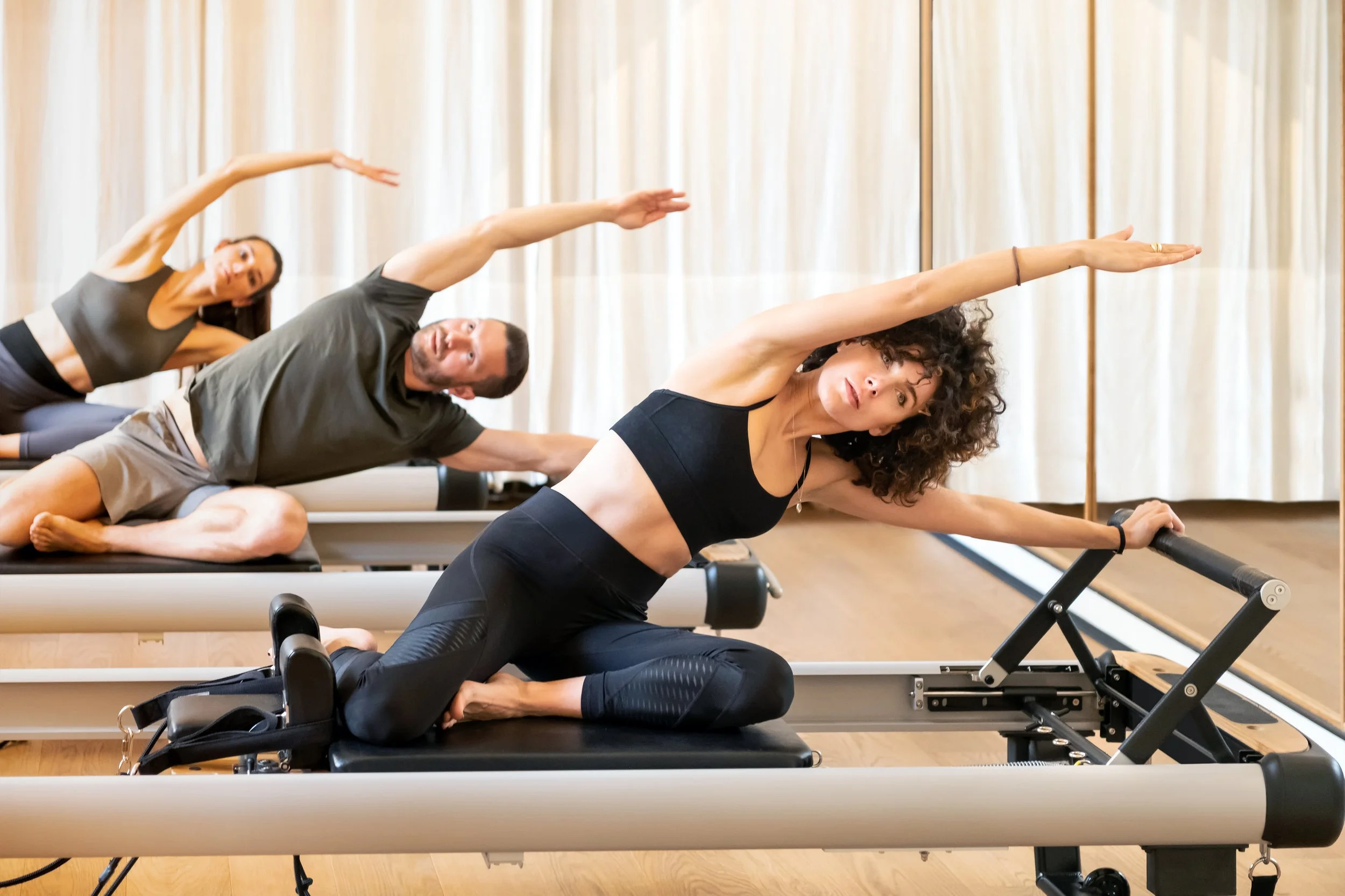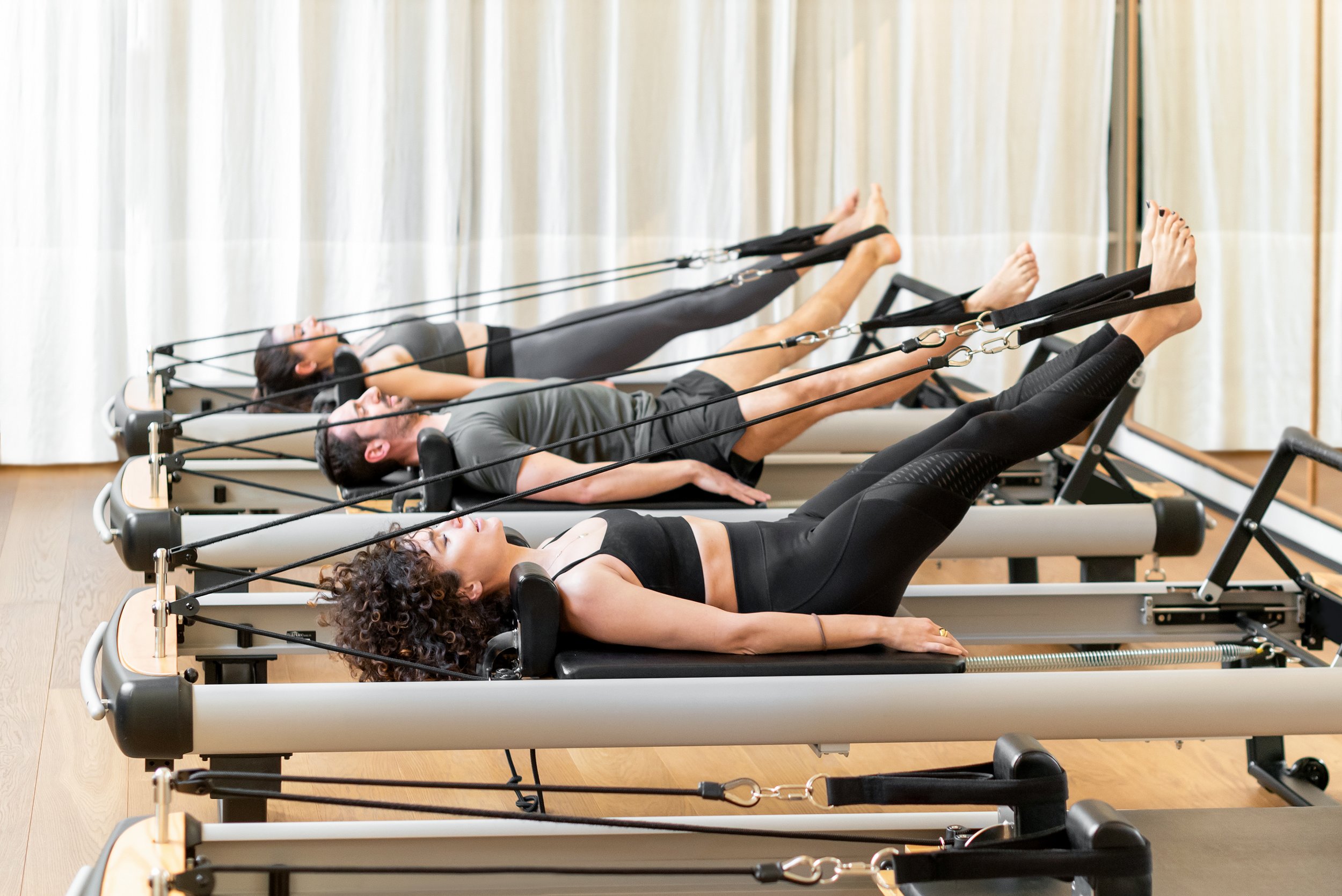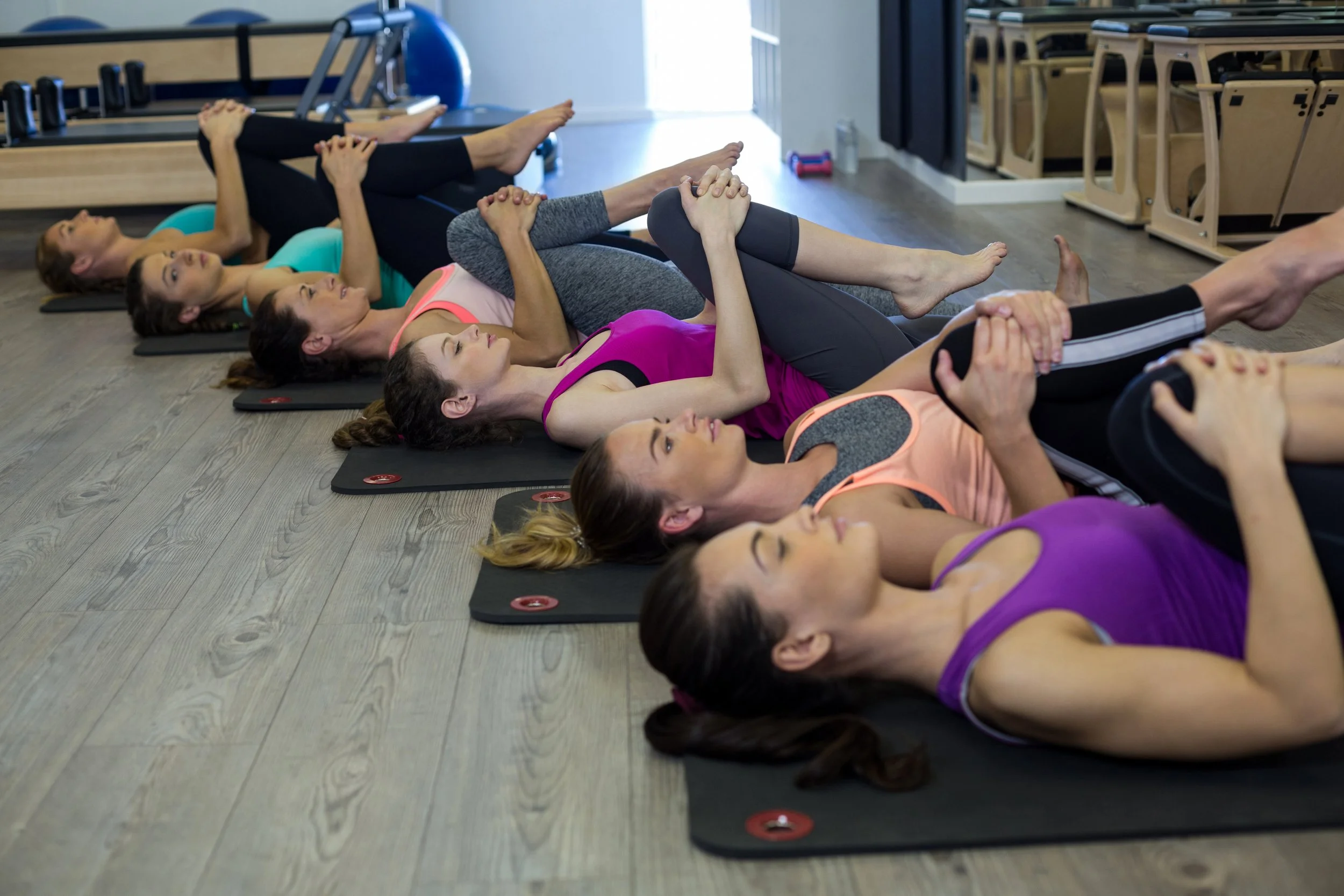Beginner’s Guide to Pilates
Pilates uses a combination of approximately 50 simple, repetitive exercises to create muscular exertion. Advocates of this system of exercise claim that exercises can be adapted to provide either gentle strength training for rehabilitation or a strenuous workout vigorous enough to challenge skilled athletes. The exercises are designed to increase muscle strength and endurance, as well as flexibility and to improve posture and balance. There is cautious support for the effectiveness of Pilates in improving flexibility, abdominal and lumbo-pelvic stability and muscular activity.
5 Things To Know Before You Take A Pilates Class
There are two different types of Pilates classes
Pilates is all about repetition and consistency
You will feel the burn in class, and you might be sore the next day
Pilates is more than just a physical workout
It's all about having fun, smiling and moving your body
HOW OFTEN SHOULD A BEGINNER DO PILATES?
If you're new to Pilates, you've probably noticed the instant boost to your physical and mental well-being. This can make it extremely tempting to do Pilates workouts more and more frequently. However, there’s a sweet spot between doing too much Pilates and not enough.
Beginners should do 1 to 3 Pilates workouts per week to see results. Research shows improvements in balance, strength, and pain reduction with one to three Pilates sessions per week. Two days per week is better than one, and three is better than two, but beyond that, there’s not much benefit.
Even though you won't have a barbell or dumbbell in your hands, Pilates is considered a form of resistance training that taxes your muscles, so resting is important. Keep reading to learn what makes this form of exercise perfect for anyone, and how you can start your Pilates journey today, from the comfort of home.
WHY IS PILATES GOOD FOR A BEGINNER?
Pilates is a great form of exercise for beginners and the physically fit alike, since the intensity of Pilates can be easily modified. Consisting of low-impact exercise and stretching, it's ideally suited for individuals just beginning their fitness journey or those undergoing rehabilitation from injury or surgery. Just because Pilates is a safe form of exercise (low risk of injury), that doesn't mean it sacrifices benefits. Quite the contrary.
HOW DO BEGINNERS DO PILATES AT HOME?
Splitting Pilates workouts into roughly two groups, mat Pilates and reformer Pilates, beginners should start with mat Pilates at home. Mat Pilates requires little to no equipment, whereas reformer Pilates requires a machine, making mat Pilates far more conducive for at-home workouts.
Reformer Pilates provides better results when you have an instructor to guide you through the workout in person, so save that for a studio visit. To do the mat Pilates workout below, all you need is your body weight - mats are optional. Let's get started.
REMEMBER, BEGINNERS DON’T NEED PILATES EVERY DAY
After learning about the benefits of Pilates and trying it for yourself, you might want to start doing it as often as possible. Resist the urge for optimal results - and don't forget you only need to go two or three times per week to see improvements. After that, there are diminishing returns. You can even do Pilates once per week and see results if that’s all you can manage.
If you can’t make it to a studio to learn from an instructor, you can do Pilates from home, since there are so many exercises that require only the weight of your body and a comfortable surface to lie on. Expect to see an improvement in your quality of life, strength, balance, flexibility, and even mental health when you start Pilates.
ChaiseFitness is a Great Pilates Studio for Beginners
At ChaiseFitness, we believe that anyone can be fit—no matter what skill level or body type. This belief inspired the creation of our patented Reinvention Method, which is for everyone—the athlete, the dancer, the beginner, the advanced, the rebuilder. We blend Pilates, ballet, and strength training and equip you with a chair and overhead bungees so that you work out all your muscles every time. We are located in Upper East Side in Manhattan. For more information, you can contact us at (973)996-2063, or visit our website.
Physical Results from Pilates
Welcome! Whether you’re a newcomer or a seasoned practitioner, you might be wondering how long it takes to see results from your Pilates program. In this friendly and informative blog post, we’ll explore the timeline for physical and mental benefits, including:
Recommended frequency and duration of practice
The role of individual variation
Measuring results and
Staying motivated in your Pilates journey.
Let’s dive in!
Physical Results from Pilates
While individual experiences will vary, many people begin to notice physical improvements within a few weeks of consistent Pilates practice (usually the initial results within about 3 weeks). This is because even in the first few weeks, your ability to activate the correct muscles and be aware of your posture begins to improve.
In particular, these changes can include better posture, increased flexibility and improved core muscle activation. However, the timeline can be influenced by factors such as your starting fitness level, the type of Pilates you’re practicing (mat or equipment-based), and the quality of instruction you receive.
As a general guide, the first significant improvements in function start to occur at the 6-7 week mark. This is because at this stage your body has started to make more efficient neural (nerve) connections into the muscles, so that when the muscles contract, they can better match the force required. As a result, even though there has not been a change in the size of the muscles, the strength has improved.
The next most significant changes are at the 13 week mark. At this stage, the growth of the muscles has begun to occur (hypertrophy), which has resulted in both more muscle and stronger muscles. Your muscles continue to grow and become stronger from 3 months to 12 months, but at a slower rate.
Improvements in posture from Pilates
One of the most noticeable outcomes of Pilates is an improvement in posture. Pilates not only enhances your posture but also makes you look taller and more confident. This is achieved by focusing on alignment, balance, and core strength, which together create a strong foundation for your body.
As you become more aware of your body’s alignment, you’ll naturally start to maintain a healthier posture, which can lead to a more positive body image.
Improvements in flexibility from Pilates
Another significant benefit of Pilates is increased flexibility. The exercises involved in Pilates stretch and strengthen your muscles simultaneously, resulting in a more flexible and supple body. The interesting contradiction from Pilates is that as you improve the stability of your joints (with improved stabilizing muscle activity around the joints), your body feels more in control, so you are able to move through larger ranges of movement and gain flexibility. More control = more flexibility.
This increased flexibility can lead to a greater range of motion, reduced muscle stiffness, and an overall more graceful appearance. As your body becomes more limber, you may find that your body image improves as well. Furthermore, Pilates focuses on developing a strong and stable center, which includes the muscles of the abdomen, back, and pelvis.
A strong core is essential for maintaining balance, stability, and overall body strength. As you progress in your Pilates practice, you’ll notice leaner and more toned muscles, leading to a more defined and sculpted physique. This enhanced physical appearance can contribute to a more positive body image.
Mental Benefits of Pilates
The mental and emotional benefits of Pilates can be just as significant as the physical ones. Many practitioners report feeling more relaxed, focused, and in tune with their bodies after a session. These mental benefits can be experienced relatively quickly, often after just a few sessions. As you continue your practice, you’ll likely notice even more significant improvements in stress management and overall mental well-being.
Frequency and Duration of Practice
If you’re looking to build muscle through Pilates, consistency and dedication are essential. That’s why I recommend committing to:
· 2-3 Pilates sessions per week (To give your body the right stimulation to grow and improve AND the appropriate amount of rest)
· (Rest is a very important part of the program. Your muscles grow when you rest, NOT when you exercise. Having enough time for recovery allows for the best results https://mdhealth.com.au/the-importance-of-rest-and-recovery/)
For at least 13 weeks
The minimum amount of time for real changes in muscle strength and growth. During this time, your body will undergo a gradual process of muscle growth and adaptation, as your muscles become stronger and more toned with each session.
By sticking to a regular schedule and pushing yourself to try new exercises and challenges, you’ll see even greater results in terms of muscle development and overall fitness. Each session should last between 30 minutes, allowing enough time for a full body workout that targets all major muscle groups.
As you progress through your Pilates program, you may find that you need to increase the frequency and intensity of your workouts to continue challenging your muscles and seeing results. This can involve adding more weight, reps, or variations to your exercises, or incorporating new equipment like resistance bands or weights.
Ultimately, the key to muscle growth through Pilates is to stay committed, stay consistent, and stay open to new challenges and experiences. With time and practice, you’ll develop stronger, leaner muscles that support your overall health and well-being.
Individual Variation
Everyone’s journey with Pilates is distinct and factors such as age, fitness level, and overall health have a considerable impact on how quickly you’ll notice progress. For example, younger individuals with a higher starting fitness level are likely to see results more rapidly than older adults or those managing health conditions. However, this should not discourage anyone from embarking on their Pilates journey. The true secret to success lies in patience, perseverance, and consistent, quality practice.
Check Out ChaiseFitness
At ChaiseFitness, we believe that anyone can be fit—no matter what skill level or body type. This belief inspired the creation of our patented Reinvention Method, which is for everyone—the athlete, the dancer, the beginner, the advanced, the rebuilder. We blend Pilates, ballet, and strength training and equip you with a chair and overhead bungees so that you work out all your muscles every time. We are located in Upper East Side in Manhattan. For more information, you can contact us at (973)996-2063, or visit our website.
Injury Recovery and Pilates
Many people turn to Pilates to seek relief from chronic pain or to aid in injury recovery. Several research studies support Pilates’ role in pain relief and as an effective rehabilitation tool.
However, did you know that Pilates can actually agitate old injuries or cause new ones if not practiced with caution? Pilates injuries are typically due to incorrect form or pushing yourself too far, so it's essential to learn from a certified Pilates instructor and respect your body and its limitations. So, what are the most common Pilates injuries and what measures can you take to avoid them and enjoy a therapeutic mind and body workout? Let’s find out.
What Are The Most Common Pilates Injury?
The most common injuries in Pilates are muscle strains, ligament sprains, and delayed onset muscle soreness (DOMS). Let’s explore the differences between each one of them and their causes.
Muscle Strains:
Muscle strains are the most common injuries in Pilates, caused by overstretching and over-exercising. It can happen by overusing a muscle (such as doing too many planks) or by incorrect form, the latter of which is the most common reason in Pilates.
Strains in the back muscles are super common as Pilates focuses heavily on core work. If the core muscles are not actively engaged when doing these exercises or your core is weak, your back muscles will take the excess strain, resulting in pains and aches. This is most common in beginners, as studies have shown the stronger your core becomes, the less likely back pain will occur.
Neck muscles are another common strain in core work. For example, holding your neck in an incorrect position in a single-leg stretch could cause a tear. But strains can happen in any part of your body, which is why learning the proper form is essential when beginning Pilates.
Ligament Sprains:
The second most commonly reported injury in Pilates is ligament strains. Unlike a muscle strain, a sprain is an injury to a ligament (or sometimes a tendon) - tissues that connect the bones of a joint.
Sprains can also occur in the upper body, particularly the wrists and neck. For example, your hand could slip on the mat in an exercise like all fours, causing a painful sprain to the wrist.
DOMS
Many new Pilates practitioners report muscle soreness for one or two days after a class, known as delayed onset muscle soreness (DOMS). This is different from a muscle strain which causes pain immediately. With DOMS, you don’t notice it until the next day.
What’s more, DOMS is a feeling of general soreness in a major muscle group rather than a targeted pain in a specific muscle. DOMS can last up to a few days and does not cause any long-lasting muscle damage.
There are various theories about why DOMS happens; one common belief is that it is due to the unfamiliar and unaccustomed stress placed on muscles, ligaments and tendons. This is why taking it easy in your first couple of Pilates classes is essential.
DOMS doesn't just happen to beginners, though. You may experience it if you've tried a new exercise or increased the intensity or frequency of your practice.
Which Pilates Exercises Are Most Prone To Injuries?
As the intensity level of Pilates movements varies, some are more prone to injury than others. Here are a few to pay extra attention to:
Roll-Ups - This Pilates move can cause lower back injuries if you have tight hip flexors or weak core muscles. Notice if you have to find momentum when rolling up or if you struggle to roll down slowly and with control. If so, try a supported roll-up with your hands on the back of your thighs until you develop more muscle strength.
Leg Stretch & Leg Circles - It can be easy to press your spine too firmly into the mat in these reclined positions. While you may think the ground will support your back, doing this too much can create spinal disc compression. Ask your Pilates teacher to show you how to find a neutral spine position to prevent this.
Plank Leg Lifts - All beginner Pilates practitioners should be cautious in plank leg lifts. Improper wrist alignment combined with weak upper body muscles can quickly result in a sprained wrist. To modify, come down onto your forearms or drop your bottom knee and forearm in a side plank.
Both mat and reformer Pilates have their unique dangers. For example, if your mat is too thin, you can cause strain to your knees or wrists in specific mat Pilates postures. Meanwhile, it is easy to hit your knee or ankle bones on the hard bars of a reformer machine, resulting in pain and potential bruising.
How To Avoid Injuries In Your Pilates Practice
While various injuries can happen during Pilates, don't fret. If you practice caution and respect your body, you can easily avoid them. Follow the tips below to ensure you keep aches and pains away.
Do Warm Up Exercises
One of the biggest mistakes when practicing Pilates at home is not warming up properly. If you are starting home practice, ensure you know the correct movements and stretches to warm up your muscles before attempting the more challenging postures.
My go-to warm-up exercises include:
Imprinting - This reclined position helps to lengthen your spine and build stability in your back by cultivating a neutral spine. This is an essential foundational Pilates pose to do before ANY core work.
Wall roll-down - A standing roll-down gives a gentle stretch to the spine and back muscles, along with opening the hamstrings. It also teaches correct posture and abdominal engagement, helping you prepare for more challenging movements like the roll-up. Wear Pilates socks for stability and focus on pressing into all four corners of your feet as you roll down.
Rolling like a ball - This is another excellent prep pose for the roll-up as it builds body awareness, promotes breath control, and strengthens the abdominal muscles. It is also a fantastic release on the lower back, so it feels particularly juicy if you have been sitting at a desk all day. I like to include this pose in both the warm-up and cool-down of my Pilates practice.
Start Slow And Progress Gradually
While trying the tricky-looking Pilates moves can be tempting, if you are new to the practice, I strongly recommend waiting before you give them a go. Attempting advanced postures before you are ready is a surefire way to cause an injury.
Honor your body and enjoy the process by focusing on finding your alignment and stability in the foundational poses. There will be plenty of time to learn advanced movements in the future!
Focus On Proper Alignment
Refrain from rushing through the movements or taking shortcuts, as this often comes hand-in-hand with incorrect alignment. Without proper form, you won't evenly distribute your weight or effort, significantly increasing the risk of strain or injury.
If you are unsure of the correct alignment of a pose, don't be afraid to interrupt the class to ask the instructor. And for this reason, don't start practicing at home until you fully understand the proper form for each pose.
Engage Your Core
Do you notice your back hurts after doing leg lifts or toe taps? This could be because you're not properly engaging your core muscles, resulting in the back muscles working overtime!
By engaging your muscles, you protect your spine and create more stability in the pose (so less shaking). A qualified and experienced Pilates instructor will demonstrate and explain how to engage your entire core (deep abdominal, pelvic floor, and stabilizing muscles).
Moreover, if you are new to core exercises, it's best to stick with beginner-friendly ones to build strength.
Listen To Your Body
Our bodies are intelligent enough to warn us when we're pushing ourselves too far. But unfortunately, we often ignore these signs and continue regardless. Cue painful injury!
I always take a few minutes to check in on how I am feeling at the beginning of each practice. This is essential because our energy levels are fleeting, and we must honor how we feel each day. If you feel fatigued, take this as a sign to slow down today. Save the challenging poses like Boomerang for those days you feel like Superwoman!
Looking for a Great Pilates Studio in Upper East Side?
At ChaiseFitness, we believe that anyone can be fit—no matter what skill level or body type. This belief inspired the creation of our patented Reinvention Method, which is for everyone—the athlete, the dancer, the beginner, the advanced, the rebuilder. We blend Pilates, ballet, and strength training and equip you with a chair and overhead bungees so that you work out all your muscles every time. We are located in Upper East Side in Manhattan. For more information, you can contact us at (973)996-2063, or visit our website.
Pilates Pains
If you’ve ever been to a Pilates class, then you’ve been sore. And, if you’re anything like us, that soreness is something you strive to achieve. After all, no pain, no gain. There is something that feels so good about being sore to the extent that you struggle to sit down in a chair. Maybe it’s because it feels like validation that you had a great workout. But what it likely is your subconscious mind knowing that those sore muscles equate to your building muscles.
But why exactly do muscles get sore?
Today we are answering that question, as well as what to do when you find yourself dealing with muscle soreness. Why are my muscles sore from my work out?
You may not know this small but important fact: working out damages your muscle. Every time you push yourself in Pilates to the point of muscle fatigue, you are making micro-tears in your muscle fibers.
While that sounds incredibly painful and like it’s a bad thing, it’s not! You feel sore as a result, but this is something you want. Each time your muscles get those micro-tears, they work to repair themselves, which means they get stronger. Every micro-tear that happens forces your body to create more muscle tissue which is where the muscle is built.
When your muscles are pushed like this, your body triggers inflammation. Additionally, your body reacts to this inflammation by bringing fluid to the area, which results in soreness. You may have heard that soreness is caused by lactic acid buildup, but that is not the case. The soreness you feel from your muscles is actually due to inflammation.
Do not see any of this as a bad thing. Micro-tears and inflammation are key to the recovery of your muscles as well as the rebuilding of your muscle tissue. Many times, you may not feel this inflammation and thus, soreness, until about 24-48 hours after your workout. This is called delayed-onset muscle soreness (DOMS). The inflammation happens immediately, but it takes your body a while to feel it.
You should expect to feel the soreness for up to 4 days, but if it lasts longer than that, you may want to check in with a professional to ensure that you aren’t putting excess stress on your body.
How do I relieve muscle soreness?
Here are some of the best ways that you can relieve muscle soreness.
Drink water. Studies have shown that if you are dehydrated, you may suffer from muscle soreness more intensely. This may be because water helps the body to get rid of waste. When you exercise and your body experiences those micro-tears, your muscles release waste and toxins that should be flushed out of the body. This waste may cause you to feel more sore, which is why water is key in helping you to get those toxins out of the body.
Do light stretching. You want to do a bit of stretching after a workout, but do not push your body too far. By trying to overstretch the muscle when it feels super tight, you may cause the muscle to become even tighter. Thus, keep your stretching light and never take it to the point where it feels painful.
Eat enough protein. Protein is key in building and maintaining muscle. Thus, you should be sure to have enough protein in your regular diet. However, if you are feeling extra sore after a workout, turn to a protein shake or another form of protein and you may find that helps to alleviate long-lasting soreness.
Sleep. Sleep is important as it gives your body a rest from doing many of its other duties and allows it to focus its attention on muscle recovery.
Looking for the Best Pilates Classes in the Upper East Side Area?
At ChaiseFitness, we believe that anyone can be fit—no matter what skill level or body type. This belief inspired the creation of our patented Reinvention Method, which is for everyone—the athlete, the dancer, the beginner, the advanced, the rebuilder. We blend Pilates, ballet, and strength training and equip you with a chair and overhead bungees so that you work out all your muscles every time. We are located in Upper East Side in Manhattan. For more information, you can contact us at (973)996-2063, or visit our website.
Pilates Plie
Pilates Plies are one of the most powerful exercises to reduce knee pain and strengthen the quadriceps muscle group. When the quads are constantly being strengthened in a shortened position, the muscles start to pull on the knee, compressing the joint and causing knee pain. These tai-chi-style plies strengthen the quads in a lengthened position, rebalancing the muscles and releasing tension on the knee. As a bonus, this exercise hydrates and loosens the sheets of fascia that surround the thighs, glutes, and lower back — realigning connective tissue fibers and helping to maintain the rebound action in your hips and knees!
Get the most out of this exercise:
Keep your knees directly over your ankle. Too wide of a stance compresses the knee joint. Too narrow stresses the tendons surrounding the kneecap. Bend only as deeply as you can without pain. The Goldilocks zone should look like a house, with your shins as sturdy walls supporting a gently sloping roof.
Turn out from your hips – not your feet! This ensures that there is no torsion to your knee. Instead, as you stand on the sole of your foot, your knees and toes will automatically line up in the same direction.
Pull up in your spine and out of your hips. This will help to decompress the spine and the hips and improve your posture.
Is Pilates good for arthritis in the knee?
Pilates offers a safe approach to alleviating symptoms and supporting healthy knees affected by arthritis. By enhancing body awareness, strengthening muscles, reducing pain, and correcting postural imbalances, it provides multifaceted benefits for those experiencing knee arthritis.
For those managing symptoms associated with arthritis, Pilates offers an alternative to traditional forms of exercise, with some research showing regular Pilates can be more effective than standard exercise at reducing pain in the knee.
Pilates can also play a preventative role for those who may be at risk of developing osteoarthritis of the knee by providing low-impact exercise to strengthen the muscles and supportive structures of the knee and improving mechanics and loading patterns. Furthermore, for those who may have undergone a total knee replacement as a treatment for knee osteoarthritis, Pilates is a great rehabilitation tool post-operatively.
Looking for the Best Pilates Studio in Upper East Side?
At ChaiseFitness, we believe that anyone can be fit—no matter what skill level or body type. This belief inspired the creation of our patented Reinvention Method, which is for everyone—the athlete, the dancer, the beginner, the advanced, the rebuilder. We blend Pilates, ballet, and strength training and equip you with a chair and overhead bungees so that you work out all your muscles every time. We are located in Upper East Side in Manhattan. For more information, you can contact us at (973)996-2063, or visit our website.
Pumped Pilates
Pilates is a form of strength training, but it doesn’t look like some of the other strength training exercises you might be familiar with. Pilates focuses more on improving muscle tone than building muscles, but the result is similar: greater stability and endurance. Pilates isn’t going to bulk you up — if anything, it’s designed to cultivate a longer, leaner look. Still, it can lay a strong physical foundation for muscle-building activities — and may even reduce your likelihood of injury. Pumped-Up Pilates is Joseph Pilates' method with a twist. We use light resistance to "pump up" the exercises, but also provide the basics for beginners.
Pumped Pilates
Build an exceedingly strong core and a gorgeous, toned body with reinvented Pilates moves that require almost every muscle.
Sleek, Strong, Sexy. That's the trademark Pilates body. Do this next-level version and you can add chiseled, fit, and fierce to the list. And you won't need a fancy machine or quirky tone-up tool to get there. Thanks to her tweaks to the workout style's signature small moves, instructors at Chaise Pilates studio in New York City, has created a bolder technique that gets deeper into your muscles and leads to even more results from the scientifically proven mat classics.
While traditional Pilates favors the abdominals, this routine puts all of your major muscles through the paces. Every movement starts in your core and then radiates to your arms and legs. Because you have to focus intently on your posture and connecting your breath to each movement, you'll use almost every muscle you have, which helps you build an exceedingly strong core and a gorgeous, balanced body.
It's basically life changing. When you do this work out, you'll experience an endorphin release, of course, but connecting your mind to your movements is really profound. Life becomes a litter sharper, and you feel less anxious. Low weights combined with basic Pilates movements Pump up Your workout creating a trim and powerful body.
Come to ChaiseFitness in Upper East Side!
At ChaiseFitness, we believe that anyone can be fit—no matter what skill level or body type. This belief inspired the creation of our patented Reinvention Method, which is for everyone—the athlete, the dancer, the beginner, the advanced, the rebuilder. We blend Pilates, ballet, and strength training and equip you with a chair and overhead bungees so that you work out all your muscles every time. We are located in Upper East Side in Manhattan. For more information, you can contact us at (973)996-2063, or visit our website.
How to Choose a Pilates Reformer
A good quality Reformer can provide client sessions for well over 20 years! When selecting a Pilates Reformer for home use, there are several key factors to keep in mind:
Choose the Right Pilates Reformer
Space: Measure the available space in your home. If you have limited space, look for a compact Reformer that can be easily stored when not in use. Consider its weight if you plan to move it frequently.
Budget: Determine how much you're willing to invest in a Reformer. While they come in various price ranges, remember that this is an investment in your health and fitness.
Adjustability: Look for a Reformer that offers a range of adjustable settings. This ensures that it can accommodate different body sizes and fitness levels, making it suitable for multiple users in a household.
Quality and durability: Check the materials used in construction. High-quality materials like steel or aluminum offer greater durability and stability. Read reviews to assess the Reformer's long-term performance.
Brand reputation: Research reputable brands that are known for producing reliable home Pilates Reformers. Brand reputation often reflects the quality of their products.
Ease of assembly: Consider whether you can assemble the Reformer yourself or if you need professional assistance. Some models are designed for easy DIY assembly.
EXAMPLES:
Workout conveniently at home with the At Home SPX® Reformer Package with Vertical Stand. From the patented rolling carriage to high-performance tension springs, the durable and easy-to-use At Home SPX is a testament to quality and craftsmanship. With its Vertical Stand, the Reformer stores upright, making it perfect for any-sized space. This Reformer package also includes a metal roll-up pole, padded platform with extender and a reformer box with foot strap. Challenge endurance, build core strength and improve flexibility with hundreds of exercises ranging in level from beginner to advanced.
Also sometimes referred to as the Trapeze Table or just the Cadillac, the Pilates Cadillac Reformer places the body into a variety of suspended positions. Using a series of ropes and pulleys, you can lift your legs and arms into the air to suspend your body over a thin mat. The primary difference between the conventional reformer and the Cadillac Reformer is the addition of horizontal and vertical bars above the table. These bars transform Pilates into a three-dimensional exercise routine you perform up in the air.
Joseph Pilates designed a few different types of Pilates chairs. The Wunda Chair is likely the most popular, but other Pilates chairs also remain in wide use. Designed by Joseph Pilates specifically for the dancer Kathy Grant, the Wunda Chair features a raised seat with a spring-loaded platform below it and to the side. From a variety of different positions, you can push down on this platform while changing the resistance to suit your needs. Sometimes somewhat tastelessly referred to as the “Electric Chair,” the Pilates Highchair is designed to raise your body vertically in the air in a variety of positions. Not so commonly used these days, the Pilates Armchair, also referred to as the Baby Chair, features a backrest that moves back and forth with varying resistances.
Try before you buy
Whenever possible, try out the Reformers you're considering before making a purchase. Attend industry events, workshops, or conferences where you can test different models and get a feel for their quality and functionality. Prioritize the safety and comfort of your clients. Look for Reformers with features like adjustable headrests, well-padded platforms, and secure strap systems. Safety should always be a top priority in your studio.
ChaiseFitness Offers Reformer Pilates Classes in Upper East Side!
At ChaiseFitness, we believe that anyone can be fit—no matter what skill level or body type. This belief inspired the creation of our patented Reinvention Method, which is for everyone—the athlete, the dancer, the beginner, the advanced, the rebuilder. We blend Pilates, ballet, and strength training and equip you with a chair and overhead bungees so that you work out all your muscles every time. We are located in Upper East Side in Manhattan. For more information, you can contact us at (973)996-2063, or visit our website.
What Are The Health Benefits Of Pilates?
The health benefits of Pilates as a form of exercise are numerous, such as physical and mental health. Here are some of the most significant benefits of Pilates.
Health Benefits Of Pilates
Improved core strength:
Pilates is known for its focus on the core muscles, which include the abdominals, back, and pelvic floor. By strengthening these muscles with resistance training, Pilates can improve overall stability, balance, and control in everyday movements.
Increased flexibility:
Pilates involves a range of dynamic stretches and movements that can help to improve flexibility and mobility. This can be particularly beneficial for those who suffer from tight muscles or limited range of motion.
Better posture:
Pilates can help to improve posture by strengthening the muscles that support the spine and promoting better alignment in the body. This can reduce the risk of injury and improve overall comfort and ease of movement.
Reduced stress and anxiety:
Like other forms of exercise, Pilates can help to reduce stress and anxiety levels by promoting the release of endorphins, the body’s natural mood-boosting chemicals. Focus on good breathing techniques really helps clients with stress and anxiety.
Improved balance and coordination:
Pilates can help to improve balance and coordination by challenging the body in different planes of movement and promoting greater awareness of body position and movement patterns.
Reduced back pain:
Pilates is often recommended for those with chronic back pain, as it can help to strengthen the muscles that support the spine and improve overall spinal alignment and posture.
Increased body awareness:
Pilates requires a high level of concentration and body awareness, which can help to improve overall mindfulness and focus on daily life.
Low-impact exercise:
Pilates is a low-impact form of exercise that can be done by people of all ages and fitness levels, making it a great option for those who want to improve their health without putting too much stress on their joints.
Versatile:
Pilates can be done using specialized equipment or simply with a mat on the floor and can be adapted to suit the needs and abilities of each individual. This makes it a versatile and customizable form of exercise.
Overall, practicing Pilates offers a range of physical benefits and mental health well-being, making it a great option for anyone looking to improve their overall fitness level and mind body connection.
Come To ChaiseFitness Today!
At ChaiseFitness, we believe that anyone can be fit—no matter what skill level or body type. This belief inspired the creation of our patented Reinvention Method, which is for everyone—the athlete, the dancer, the beginner, the advanced, the rebuilder. We blend Pilates, ballet, and strength training and equip you with a chair and overhead bungees so that you work out all your muscles every time. We are located in Upper East Side in Manhattan. For more information, you can contact us at (973)996-2063, or visit our website.
Expectations for Pilates Classes
When anyone is trying a new workout to see how it will fit with their daily schedule, one of the first things they should understand is the expectations. What do they expect to get from this routine? What are the expected results? What should they expect to focus their energy on in regard to the challenges? Our expectations can sometimes outweigh the experience and initial results, which can lead us down the path of discouragement and disappointment. But that doesn’t have to be the case if we set achievable expectations. When it comes to Pilates, what should a beginner expect and how does it evolve into the next level?
EXPECTATIONS OF BEGINNERS
When a student begins their Pilates training, they should expect to spend much of their time learning the fundamentals, which will allow them greater success as they evolve into advanced levels. First, it is important to build up control, awareness, and the correct muscle engagement for the intended position. Stabilization and breathing, in conjunction with preparing for the upcoming movement, is imperative to advancement. Understanding where the pelvic placement is and being able to adjust according to instruction, as well as realizing proper positioning and spine lengthening in support of the body while moving between postures, is also to be expected in the early stages. These fundamentals are key to creating a quality basis to continue Pilates training. After some experience with Pilates, a student will begin to naturally connect breath and movement, while maintaining stable pelvic positions and control on the equipment.
EXPECTATIONS OF INTERMEDIATE
By this point, a student will recognize exercises by name and their corresponding equipment, and due to naturally connecting their breathing and movement, they will be able to work at a quicker pace without a need for direction from the instructor. A student at this level will also understand how their bodies will respond and can modify exercises if necessary. Because of the fundamentals learned previously, an intermediate student can also incorporate dynamic movement, flowing through transitions with safety and more complex positioning. They also know the proper order of classical positions, and, therefore, can complete their workout with minimal interruption.
EXPECTATIONS OF ADVANCED
What an advanced student can achieve: the ability to flow through a controlled and efficient workout, even when variations are requested by the instructor. An advanced student can activate muscles on demand and adjust positioning while on an unstable surface without assistance, and many at this level even become instructors themselves.
Becoming an advanced Pilates student does not occur unless the fundamentals are second nature; one does not exist without the other. Pilates is a deliberate and specific exercise regimen that requires dedication and discipline, but once the fundamentals are set, it can become the most thorough and inspiring workout for all body types and physical needs. Call us today and see if Pilates is the right fit for you!
ChaiseFitness is the Best Pilates Studio in Manhattan!
At ChaiseFitness, we believe that anyone can be fit—no matter what skill level or body type. This belief inspired the creation of our patented Reinvention Method, which is for everyone—the athlete, the dancer, the beginner, the advanced, the rebuilder. We blend Pilates, ballet, and strength training and equip you with a chair and overhead bungees so that you work out all your muscles every time. We are located in Upper East Side in Manhattan. For more information, you can contact us at (973)996-2063, or visit our website.
Pilates: The Modern Exercise
Today, the Pilates method is recognized as a low-impact form of exercise that can improve physical and mental well-being. It is often used as a complement to other types of training, as well as a form of rehabilitation for those recovering from injuries or surgeries. The method emphasizes core control, proper alignment, and controlled movements, and is known for its ability to improve posture, balance, and coordination.
What is Pilates?
Pilates is a form of exercise that has gained popularity in recent years due to its focus on core control, flexibility, and alignment. Created by Joseph Pilates in the early 20th century, the practice was originally called “Contrology” and was designed to improve physical and mental health benefits through a series of controlled movements.
Today, Pilates is recognized as a low-impact form of exercise that can be done by people of all ages and fitness levels. Pilates is perfect for mother-daughter workouts. It is often used as a complement to other workouts and types of exercise, such as weight training or cardio, as it can help to improve posture, balance, functional movement and coordination. Additionally, Pilates has been shown to have a positive impact on mental health, reducing stress and anxiety levels in those who practice it regularly.
Pilates exercises:
One of the key principles of Pilates is the focus on the core muscles, which include the abdominals, back, and pelvic floor. By strengthening and improving the muscle tone of these muscles, Pilates can improve stability, balance, and control in everyday movements. This can be particularly beneficial for those who suffer from chronic back pain or other muscular imbalances.
Pilates exercises are very suited to pregnant women throughout all stages of their pregnancy and for their recovery. Pilates moves and exercises are popular among pregnant women and teaching women’s health has become very popular in Physiotherapy. Most practices will run a few classes to cater for women’s health and pregnancy.
Another important aspect of Pilates is the emphasis on alignment and proper form. Each movement is performed with precision and attention to detail, which can help to prevent injury and maximize the benefits of the exercise. Pilates instructors often provide hands-on guidance and feedback to ensure that students are performing the movements correctly and safely to gain maximum benefit.
Pilates exercise can be done using specialized equipment, such as the Reformer or Cadillac, or simply with a mat on the floor. Equipment such as resistance bands, magic circle and own body weight are often used for strength training. Many Pilates studios offer classes in a group setting, but private sessions with a certified instructor are also available for those who want more personalized attention.
Overall, Pilates caters for everyone, being a versatile and effective form of exercise that can have health benefits for anyone looking to improve their physical and mental well-being. Whether you are recovering from musculoskeletal injuries, looking to supplement your current fitness routine, or simply wanting to improve your posture and core strength, Pilates is a training method to consider as part of your exercise program.
Check Out ChaiseFitness Today!
At ChaiseFitness, we believe that anyone can be fit—no matter what skill level or body type. This belief inspired the creation of our patented Reinvention Method, which is for everyone—the athlete, the dancer, the beginner, the advanced, the rebuilder. We blend Pilates, ballet, and strength training and equip you with a chair and overhead bungees so that you work out all your muscles every time. We are located in Upper East Side in Manhattan. For more information, you can contact us at (973)996-2063, or visit our website.
Pilates for Body Sculpting
If you’re interested in learning more about body sculpting with Pilates, you’ve come to the right place! Today, we’re going to explore the fascinating world of Pilates and its potential to tone your body. In this blog post, we’ll discuss what toning means in the context of physical fitness, the benefits of Pilates for toning, the science behind it, and how Pilates compares to other popular forms of exercise. We’ll also offer tips for maximizing your toning results with Pilates. Let’s get started!
The Definition of Body Sculpting
In the realm of fitness, Body Sculpting generally refers to the process of increasing muscle definition and reducing excess body fat. This creates a more toned and lean appearance. Pilates, a form of exercise that emphasizes controlled movements, breath, and alignment, can indeed contribute to toning your body. By targeting specific muscle groups and engaging your core, Pilates can help you develop long, lean muscles and improve overall body composition.
The Benefits of Pilates for Toning:
One of the most significant benefits of Pilates is that it can improve your muscle strength. Pilates focuses on working your core muscles, including your abdominal muscles, lower back muscles, and hip muscles. Strengthening these muscles can improve your overall muscular strength and help you maintain better balance and stability. With consistent practice, you can expect to see noticeable toning in your abdominal area and throughout your body.
Another benefit of Pilates is that it can enhance your flexibility. Pilates exercises involve slow, controlled movements that help improve your range of motion and elongate your muscles. This can help create a toned and lean appearance in your muscles. With regular practice, you can expect to become more flexible and feel less stiff. Pilates also emphasizes proper body alignment, which can lead to better posture. Poor posture can contribute to back pain and make you appear shorter and less toned.
With Pilates, you’ll learn how to align your body properly, which can make you appear taller and more toned. This can have a significant impact on your overall appearance and confidence.
Also, Pilates can improve your body awareness. By practicing Pilates, you’ll become more in tune with your muscles and movement patterns. This increased awareness can help you engage the right muscles for a more effective workout and better toning results. You’ll also become more mindful of your body throughout the day, which can help you maintain good posture and avoid injury.
The Science Behind Pilates and Toning:
Here are three great studies focusing on the science behind Pilates and toning, specifically targeting physiotherapists:
Cruz-Ferreira, A., Fernandes, J., Laranjo, L., Bernardo, L. M., & Silva, A. (2011). A systematic review of the effects of Pilates method of exercise in healthy people. Archives of Physical Medicine and Rehabilitation, 92(12), 2071-2081. doi: 10.1016/j.apmr.2011.06.023
This systematic review investigates the effects of Pilates on healthy individuals, including improvements in muscle strength, toning, and flexibility. The authors highlight the growing interest of physiotherapists in using Pilates as an adjunct to traditional rehabilitation practices. The review also discusses the potential benefits of Pilates for individuals with various medical conditions, suggesting its applicability in the field of physiotherapy.
Wells, C., Kolt, G. S., & Bialocerkowski, A. (2012). Defining Pilates exercise: A systematic review. Complementary Therapies in Medicine, 20(4), 253-262. doi: 10.1016/j.ctim.2012.02.005
This systematic review aims to define Pilates exercise and identify its core components, making it easier for physiotherapists and other practitioners to implement the method into their practice. The authors analyze various studies to determine the key principles and techniques of Pilates. They conclude that Pilates is an effective exercise modality for improving muscle tone, strength, and flexibility, which are crucial aspects of rehabilitation and injury prevention in physiotherapy.
Latey, P. (2001). The Pilates method: History and philosophy. Journal of Bodywork and Movement Therapies, 5(4), 275-282. doi: 10.1054/jbmt.2001.0237
In this study, the author provides a comprehensive overview of the Pilates method, including its history and philosophy. Latey highlights the effectiveness of Pilates in addressing the needs of both healthy individuals and patients undergoing rehabilitation. The study emphasizes the role of physiotherapists in incorporating Pilates into their practice to enhance muscle tone, flexibility, and overall physical well-being.
These studies provide valuable insights into the science behind Pilates and its effectiveness in promoting muscle toning, strength, and flexibility. They emphasize the growing interest among physiotherapists in incorporating Pilates into their practice as a complementary method to traditional rehabilitation techniques.
Pilates and Other Forms of Exercise:
When it comes to toning your body, Pilates is not the only option. Weightlifting, for example, can also be effective in promoting muscle growth and fat loss. However, the two forms of exercise have different approaches. Pilates focuses on building long, lean muscles and promoting flexibility, while weightlifting often emphasizes building larger muscles and increasing overall strength. Depending on your personal goals and preferences, you may find that a combination of Pilates and other forms of exercise is the most effective way to achieve your desired level of toning.
Pilates for body sculpting
In conclusion, Pilates is a fantastic way to tone and strengthen your body, and by following the tips above, you can maximize your results and achieve the toned, sculpted physique you’ve been striving for.
Remember to find a qualified instructor, set realistic goals, be consistent, combine Pilates with cardio, and incorporate a healthy diet into your routine. And above all, be patient and stay committed to your practice.
Check Out ChaiseFitness for the Ultimate Pilates Experience
At ChaiseFitness, we believe that anyone can be fit—no matter what skill level or body type. This belief inspired the creation of our patented Reinvention Method, which is for everyone—the athlete, the dancer, the beginner, the advanced, the rebuilder. We blend Pilates, ballet, and strength training and equip you with a chair and overhead bungees so that you work out all your muscles every time. We are located in Upper East Side in Manhattan. For more information, you can contact us at (973)996-2063, or visit our website.
Chiropractor or Reinvention Pilates?
Low back pain, or LBP, is a very common condition which affects the lumbar spine, or the lower section of the spine. Approximately more than 3 million cases of LBP are diagnosed in the United States every year and about 80 percent of adults worldwide experience low back pain at some point during their lifetime. Low back pain is generally caused by injury to a muscle (strain) or ligament (sprain) or due to damage from a disease. Common causes of LBP include poor posture, lack of regular exercise, improper lifting, fracture, herniated discs and/or arthritis. Most cases of low back pain may often go away on their own, however, when LBP becomes chronic, it may be important to seek immediate medical attention. Two therapeutic methods have been utilized to improve LBP.
Chiropractor or Reinvention Pilates?
Today, chronic low back pain is one of the special challenges in healthcare. There is no unique approach to treat chronic low back pain. A variety of methods are used for the treatment of low back pain, but the effects of these methods have found that reinvention Pilates are more effective at pain control than Chiropractic treatments.
Lower Back Pain:
Low back pain with a history of more than 3 months and without any pathological symptoms is called chronic low back pain. For patients with chronic low back pain, the physician should take into consideration the likelihood of muscle pain development with spinal origin, in addition to low back pain with unknown origin. This type of pain may be mechanical (increase in pain with movement or physical pressure) or nonmechanical (increase in pain at the rest time). Low back pain or spine pain is the most common musculoskeletal complication. About 50%–80% of healthy people may experience low back pain during their lifetime, and about 80% of the problems are related to the spine and occur in the lumbar area.
Low back pain may be caused by trauma, infection, tumors, etc. Mechanical injuries which are caused by overuse of a natural structure, deformity of an anatomical structure, or the injury in the soft tissue are the most common reasons for back pain. From occupational health perspective, back pain is among the most important reasons for the absence from work and occupational disability; in fact, the longer the period of disease, the less likely it is to improve and return to work. Disability due to low back pain in addition to disturbance in doing daily and social activities has a very negative effect, from social and economic perspectives, on the patient and the community, which makes chronic low back pain highly important. Today, chronic low back pain is one of the critical challenges in medicine.
Patients with chronic low back pain are responsible for 80% of the costs paid for the treatment of low back pain that is also the reason for mobility restrictions in most people under 45 years. In the developed countries, the overall cost paid for low back pain per year is 7.1 of total share of the gross national product. Clearly, most of the cost is related to counseling and treatment of patients with chronic low back pain rather than with intermittent and recursive low back pain. The existence of various methods of treatment is because of no single cause of low back pain. A variety of methods such as pharmacotherapy, acupuncture, infusions, and physical methods are the most common interventions for treatment of low back pain. However, the effects of these methods remain to be fully known. An exercise program, developed based on the physical conditions of patients, can promote the quality of life in patients with chronic disease.
Pilates:
Literature shows that the effect of exercise in controlling chronic low back pain is under study and there is strong evidence about the fact that movement therapy is effective to treat low back pain. However, no specific recommendations exist about the type of exercise, and the effects of certain types of movement therapies have been determined in few studies.
Pilates training consists of exercises that focus on improving flexibility and strength in all the body organs, without increasing the mass of muscles or destroying them. This training method consists of controlled movements that form a physical harmony between the body and brain and can raise the ability of the body of people at any age. In addition, people who do Pilates exercise would have better sleep and less fatigue, stress, and nervousness.
This training method is based on standing, sitting, and lying positions, without intervals, jumping, and leaping; thus, it may reduce injuries resulting from the joint damage because the exercise movements in the ranges of motion in the above three positions are performed with deep breathing and muscle contraction.
Pilates training can be an effective method for improving general health, athletic performance, proprioception, and reduction of pain in patients with chronic low back pain. The improvements in strength seen in the participants in the present study were more likely to be due to decrease in pain inhibition than to neurological changes in muscle firing/recruitment patterns or to morphological (hypertrophic) changes in the muscle.
Check Out ChaiseFitness Today
At ChaiseFitness, we believe that anyone can be fit—no matter what skill level or body type. This belief inspired the creation of our patented Reinvention Method, which is for everyone—the athlete, the dancer, the beginner, the advanced, the rebuilder. We blend Pilates, ballet, and strength training and equip you with a chair and overhead bungees so that you work out all your muscles every time. We are located in Upper East Side in Manhattan. For more information, you can contact us at (973)996-2063, or visit our website.
Virtual Open Level Mat Pilates
Virtual Open Level Mat is a 30 minute Pilates mat class for those who are somewhat familiar with Pilates mat work. This class is recommended for anyone looking to personally challenge themselves on the mat. It's easy to do in the comfort of your home. All you need is a mat, and depending on the class, a few easy to find props around your home. The teacher will provide modifications and variations to suite the appropriate needs of the class.
Virtual Open Level Mat Pilates
Pilates mat work is the basis for the entire Pilates system of exercises. In general, a traditional Pilates mat class will work your legs, stomach, lower and upper back muscles. On the mat, your body weight provides resistance against gravity, making the workout more challenging in many cases. You must be in full control of your body, rather than relying on the assistance or support of the springs and cables of an apparatus. Mat work is a great option for beginners because of its emphasis on learning how to control your muscles during exercises.
But don’t be fooled, advanced classes with the mat are the hardest because you’re using your body all the time, the reformer isn’t there assisting or supporting you. While doing Pilates on a mat instead of a Reformer may not seem as exciting or challenging, many clients see results (improved strength, posture, agility, flexibility, toned muscles) within just a few mat sessions.
Benefits:
Both the reformer and the mat are beneficial to building up your core strength and toning your muscles. Both methods train you to initiate the movements from your body’s powerhouse (your core/centering) and accordingly will quickly translate into benefits across your day-to-day activities. While you can perform the same series of exercises on the reformer that you can on the mat, the workouts are notably different. Mat classes utilize body weight for exercises, while the Reformer adds resistance to the Pilates exercises via the use of the springs that form part of the machine.
Fast results:
Still can’t decide between Mat or Reformer Pilates? There is no need to agonize over the decision; most people will reap similar benefits from both methods. Both will teach you how to effectively use your powerhouse, building strength in your body’s core, which will quickly translate to benefits in your day-to-day activities or sports. While targeting specific muscle groups is possible on the mat, the combinations of exercises aren’t as varied as the reformer. The reformer is also more ideal than the mat for those with injuries or chronic imbalances. The biggest misconception is that Reformer Pilates is harder than Mat Pilates, when in fact it can be the opposite in an advanced class (which will lead to faster results). What is critical is that regular practice is maintained and that the principles of Pilates (breath, centering, concentration, control, precision and flow) are adhered to throughout a class to maximize the results you will see.
Check Out ChaiseFitness Today
At ChaiseFitness, we believe that anyone can be fit—no matter what skill level or body type. This belief inspired the creation of our patented Reinvention Method, which is for everyone—the athlete, the dancer, the beginner, the advanced, the rebuilder. We blend Pilates, ballet, and strength training and equip you with a chair and overhead bungees so that you work out all your muscles every time. We are located in Upper East Side in Manhattan. For more information, you can contact us at (973)996-2063, or visit our website.
How Pilates Changes the Body
Pilates focuses on building strength and muscle tissue. This is something referred to as body recomposition. Body recomposition helps people build lean muscle mass and raise their basal metabolic rate (BMR), enabling them to burn more calories, including when they are static or resting. A person’s BMR determines the number of calories they burn while at rest. The leaner muscle tissue a person has, the more calories they require to keep tissue primed and fed. Therefore, the more muscle people have, the more calories their bodies burn while at rest.
How Pilates Changes the Body
Improving body composition through consistent muscle strengthening techniques can help build lean muscle and reduce body fat, also often resulting in weight loss. This is something that Pilates can facilitate through its core movements and philosophy of mindfulness between a person and their body.
How often should Pilates be done?
An older systematic review of studies on the effects of Pilates on body composition, published in the Journal of Bodywork and Movement Therapies, found that doing 60 minutes of Pilates practice 5 times per week for 4 weeks was best for promoting changes in body composition.
However, devoting any amount of time to improving fitness is invaluable. The Centers for Disease Control and Prevention (CDC) and the Physical Activity Guidelines for Americans recommend that adults perform 150 minutes of moderate to intense activity per week.
Effective weight loss tips include:
Eating a nutritious, high protein diet: Eating a diet high in protein will help keep a person more satiated and, therefore, more likely to stay in a calorie deficit. This is because protein reduces the hunger hormone (ghrelin) and increases the hormone that helps a person feel full.
Doing aerobic exercise: To prevent spiking the appetite, a person can try aerobic workouts that engage the cardiovascular system, such as uphill walking.
Starting resistance training: Opting for resistance training as part of a fitness regimen increases BMR, ensuring that a person burns the optimal amount of calories, even while resting.
Trying intermittent fasting: Intermittent fasting, which involves going 16 or more hours at a time without eating, can people lose fat while maintaining muscle mass. It can also help people monitor or reduce their calorie intake.
There is considerable evidence to suggest that Pilates is an effective workout technique with numerous benefits that can help people lose weight in a healthy way. For people to experience the greatest weight loss benefits of Pilates, it is best to consistently practice it multiple times per week.
However, weight loss requires a calorie deficit. Therefore, to see results, it is important to ensure a healthy and sustained calorie deficit in combination with any workout plan. For the best results, a person may wish to combine Pilates workouts with a nutritious, high protein diet.
Check Out ChaiseFitness Today
At ChaiseFitness, we believe that anyone can be fit—no matter what skill level or body type. This belief inspired the creation of our patented Reinvention Method, which is for everyone—the athlete, the dancer, the beginner, the advanced, the rebuilder. We blend Pilates, ballet, and strength training and equip you with a chair and overhead bungees so that you work out all your muscles every time. We are located in Upper East Side in Manhattan. For more information, you can contact us at (973)996-2063, or visit our website.
Pilates and Pregnancy
If you’re debating whether or not to do Pilates during pregnancy, rest assured that prenatal (and postnatal!) Chaise Fitness Pilates is a great idea, BUT there are some disclaimers we must share first.
Pilates and Pregnancy
Pilates has amazing health benefits, and it’s a smart, low-impact way for expecting mothers to stay in shape throughout their pregnancy. However, it is important that our mommas-to-be have customized routines throughout all pregnancy stages. A customized Pilates routine is beneficial to a future mother and her baby for a variety of reasons. Not only can it help develop the muscles used during birth, but the fitness benefits (of strengthening and toning all the ancillary muscles) can also be experienced postpartum. As our female bodies change during pregnancy, Pilates can help us become reacquainted with our inner strength and have a greater understanding of the mind/body connection.
However, while Pilates can be super beneficial for both you and the baby, there are moves and sections of each repertoire that are better left for after pregnancy. For instance, routines that are over-strenuous, high-impact or face-down (prone) are typically discouraged. However, exercises such as deep core stabilizing, oblique strengthening and moves surrounding pelvic stability are usually welcomed to help prepare you for carrying the baby, and also for when it comes time to push.
Before considering prenatal Pilates, you must consult with your physician, and THEN, you and your instructor should have a chat about your personal goals/limitations, including which trimester you’re in and your previous experience with Pilates. If you are unfamiliar with Pilates, your instructor may recommend more foundational (essential) classes or private appointments. If you are familiar with Pilates, your instructor will likely make you aware of which class segments to skip or modify. And, as an extra precaution, at Chaise Fitness Pilates, we require a note from your OBGYN to confirm your doctor’s approval to boom your heart out during pregnancy. But, having these things in mind, prenatal Pilates can do wonders for both you and your baby.
The rest is all about timing.
First Trimester
The first trimester is when you and your little bundle of joy are going through some big initial changes. While the baby is growing a heartbeat, your body is busy at work with fluctuating hormones. Though pregnancy experiences as a whole can be different for all women, fatigue is quite common for many during the first trimester. One of the ways to combat this is to stay active. If you are interested in prenatal Pilates and don’t have any previous experience, the best time to begin is during your first trimester. This is ideal for beginners who are unfamiliar with the routines and equipment and would prefer a group setting. Starting early will also give you and your instructor time to develop a fitness plan detailing how to Chaise Fitness Pilates throughout your pregnancy.
Second Trimester
The second trimester occurs from the 13th through the 27th week of pregnancy. Once you reach this stage, it’s typically recommended that you and your instructor move toward private classes. This will allow the instructor to provide extra care and attention, as well as a personalized routine. Be sure to seek out a nationally accredited Pilates Instructor for this second trimester (and on). You want to find a professional coach who studied anatomy and special populations with a fine-tooth comb, and this is often aligned with most national accredited Pilates Instructor training programs.
As your baby continues to grow strong during the second trimester, you might also find yourself with peculiar food cravings. This is your body’s way of getting the baby their necessary nutrients. During this stage, weight gain can be a concern for some women, and Pilates or staying active can help with that. Pilates during this stage will mostly involve stretching to avoid any unnecessary strain.
Third Trimester
That brings us to the 28th week until conception: the third trimester. You’re almost there! We would not recommend taking on the sport of Pilates (or any other new sport) during this final stage of your pregnancy. At this point, balance can be difficult to hold, and it may prove difficult to learn new choreography, strengthen totally new muscle groups, or stretch your bod in new ways. However, we do recommend talking with your primary care physician about walking or other low-impact exercises in this stage of the game. Movement is key to helping make the delivery process as smooth as possible if your body (and baby) grant you able.
Postpartum
Now, finding inner core strength after giving birth can be notoriously tricky, but Pilates is ideal and totally here to help! As a matter of fact, postpartum Pilates is what inspired our founder to establish Chaise Fitness Pilates.
Getting back into a fitness routine after giving birth is often difficult for new mothers, due in part to growing responsibilities, lack of sleep, and new family schedules. But if Pilates can enter a new momma’s postpartum world, it is totally worth it! Post-delivery, it’s no secret, our bodies change significantly, but the Chaise Fitness Pilates provides a way to get reacquainted with ourselves mentally and appreciate our strong, human-making bodies. Working with a professional certified instructor one-on-one can ensure that you get a jump-start on strengthening weakened core muscles. Just make sure to check-in with your healthcare provider for the go-ahead to begin exercising again…you’re likely looking at 6-12 weeks post baby for this green light.
By customizing routines to fit your unique body, posture and goals, Pilates can be a perfect way to find fitness pre/post-delivery. With guidance from our talented and certified Pilates instructors here at Chaise Fitness Pilates, you can improve core muscle strength (great for pushing) and back strength (for carrying the baby). Not to mention, Pilates classes provide a much-needed endorphin boost and a feeling of positive body-love. We can’t wait to be a part of your motherhood journey and celebrate your exciting pregnancy with you.
Check Out ChaiseFitness Today
At ChaiseFitness, we believe that anyone can be fit—no matter what skill level or body type. This belief inspired the creation of our patented Reinvention Method, which is for everyone—the athlete, the dancer, the beginner, the advanced, the rebuilder. We blend Pilates, ballet, and strength training and equip you with a chair and overhead bungees so that you work out all your muscles every time. We are located in the Upper East Side in Manhattan. For more information, you can contact us at (973)996-2063, or visit our website.
Beautiful Bodies from Pilates
Wouldn’t it be wonderful if, as Valentine’s Day approaches, you can emphasize beauty? Our schedules often get busy. In this hustle, it's too easy to let self-care routines slide. However, it doesn't have to be this way. Here's a tip: set your alarms early and prioritize your self-care before the rest of the world – your kids, your neighbors, your busy schedule – wakes up.
What are the benefits of early morning exercise? Exercising first thing in the morning offers major advantages, such as:
Improved Focus and Mental Clarity: Engaging in physical activity early in the day can boost brain function, resulting in better concentration and productivity.
Elevated Mood: Exercise releases endorphins, which can improve mood and reduce stress and anxiety, setting a positive tone for the day.
Increased Energy Levels: Regular morning workouts can lead to higher energy levels throughout the day, as opposed to feeling sluggish or tired.
Beautiful bodies from Pilates
It’s possible to strengthen, improve flexibility, and sculpt with Pilates—but as we’ll soon see, it’s typically not enough on its own to achieve significant muscle gains. At any rate, Pilates helps to maintain muscle since it’s a form of resistance training. Many Pilates exercises incorporate the full body or, at the very least, a single Pilates class will typically ensure that you work all your muscles at different times.
Still, certain muscle groups tend to take precedence. Pilates is highly focused on alignment, posture, stability, and moving with integrity, which ends up targeting the core (front and back body), glutes, and in some ways, mobility.
The Benefits of Pilates for Muscle Development
Those who are new to Pilates may find that they build muscle at the start—namely since they’ll target muscles they’re not used to activating—yet they may end up hitting a plateau without adding that extra oomph. Pilates offers countless benefits for your body—not to mention your mind, health, and overall sense of well-being. Yet in most cases, it typically won’t suffice to adequately build muscle. In order to increase muscle mass, you need to continuously level up with added resistance or weight, which involves a process called hypertrophy.
Per the National Academy of Sports Medicine, hypertrophy is “the enlargement of skeletal muscle fibers in response to being recruited to develop increased levels of tension … [which] is characterized by an increase in the cross-sectional area of individual muscle fibers resulting from an increase in myofibril proteins (myofilaments).” In simple terms, increased tension causes muscle fibers to tear, and the body will then fuse those fibers back together with new muscle cells to build muscle mass. So, unless you’re consistently increasing resistance with your Pilates regimen, you’re more likely to maintain, rather than gain, muscle.
But just because Pilates isn’t the ideal workout to build muscle, it doesn’t mean that you should skip it if you want to bulk up. In fact, Pilates offers several benefits that can complement muscle development, including:
Increased muscle strength
Improved endurance
Enhanced flexibility
Better posture and balance
Greater body awareness
These perks can facilitate longer, more effective workouts—including if you choose to do standard weightlifting—all the while providing functional benefits for your body. Sign up to get on the morning exercise benefits training!
Looking to Start Pilates Classes in the Upper East Side Area?
At ChaiseFitness, we believe that anyone can be fit—no matter what skill level or body type. This belief inspired the creation of our patented Reinvention Method, which is for everyone—the athlete, the dancer, the beginner, the advanced, the rebuilder. We blend Pilates, ballet, and strength training and equip you with a chair and overhead bungees so that you work out all your muscles every time. We are located in the Upper East Side in Manhattan. For more information, you can contact us at (973)996-2063, or visit our website.
Pilates and Feet
The human foot is a marvel of biological engineering, comprising 26 bones – that's about a quarter of all the bones in your body! With 33 joints formed where these bones meet, the foot is a complex network. The presence of so many joints means there are many points where movement occurs, and with movement comes the potential for wear, tear, and various forms of stress. However, mother nature has been thoughtful in designing these joints, equipping them with a robust support network of ligaments, muscles, and arches.
Ligaments provide stability:
Ligaments are the tough bands of fibrous tissue that connect bones to other bones. In the foot, they are crucial for maintaining the structure and alignment of joints, thereby providing stability. We want stable foundations, right? These ligaments prevent excessive movement that could lead to joint injuries, ensuring that the foot can withstand the demands of daily activities and more strenuous exercises.
Muscles facilitate movement:
Muscles in the foot and the lower leg work in harmony, showcasing the interconnectedness of the kinetic chain. The intrinsic muscles, nestled within the foot, play a critical role in fine-tuning movements and maintaining the arches. Meanwhile, the extrinsic muscles, originating in the calf area and connecting to the foot through tendons, govern larger movements, such as flexing and extending the foot. That’s right – some of your foot muscles are actually located outside your feet! This reveals a fundamental truth: examining foot health also means considering areas beyond the foot itself, just as addressing back health often involves looking at foot health as mentioned previously.
This dynamic relationship underscores the kinetic chain principle we’re trying to drive home, here the functionality of one part is intricately linked to another. The extrinsic muscles, situated in the ankle and calf, demonstrate that issues in the foot can have repercussions in the lower leg, and the reverse is also true. The well-being and efficiency of these muscles are vital not only for foot-specific movements but also for the overall coordination and balance of the lower body. This is especially crucial for activities like walking, running, and balancing, where seamless interaction within the kinetic chain is essential.
Key Functions of Intrinsic Muscles:
Toe Movement: They facilitate movements such as toe flexion, extension, abduction, and adduction.
Arch Support: By supporting the foot's arches, they play a pivotal role in shock absorption and weight distribution.
Stability: These muscles enhance the stability of the foot, aiding in balance and providing a solid base for larger movements.
Key Functions of Extrinsic Muscles:
Movement Control: They are primarily responsible for the powerful movements of dorsiflexion (raising the foot) and plantarflexion (lowering the foot).
Stability in Motion: These muscles contribute to the stability of the ankle joint, essential during dynamic activities like running or jumping.
Energy Efficiency: Extrinsic muscles play a role in energy conservation during movement, utilizing the stretch-shortening cycle for efficient force production.
Arches absorb impact and distribute weight.
The foot's arches play a critical role in how we move. These arches, formed by the bones' arrangement and supported by ligaments and muscles, help absorb the impact from activities like walking or jumping. They also distribute weight across the foot, which is crucial for maintaining balance and providing a stable foundation for movement. The health and integrity of these arches are vital for overall foot function.
Three arches of the foot:
Medial Arch (Inside of the Foot)
This arch runs from the heel to the ball of the foot along the inside edge. It's the most prominent and is crucial for absorbing shock when your foot hits the ground. The medial longitudinal arch helps in distributing body weight during standing and walking, playing a significant role in how we adapt to various surfaces.
Impact Up the Chain: A well-functioning medial arch can prevent excessive inward rolling of the foot (overpronation), which can lead to knee and hip alignment issues.
Lateral Arch (Outside of the Foot)
Lower and less pronounced, this arch runs along the outer edge of the foot. It provides balance and support, particularly when walking on uneven surfaces. The lateral arch works in conjunction with the medial arch to distribute weight and absorb impact.
Impact Up the Chain: A strong lateral arch supports the outer foot, helping to maintain balance and preventing excessive strain on the outer leg muscles.
Transverse Arch (Across the Middle of the Foot)
This arch is located across the midfoot, formed by the cuboid, cuneiform bones, and the bases of the first to fifth metatarsal bones. It is crucial for maintaining the foot's flexibility and assisting in weight distribution across the forefoot.
Impact Up the Chain: The transverse arch helps in stabilizing the foot and plays a role in efficient toe-off during walking or running, affecting the overall gait and posture.
This intricate system works together not just for the well-being of your feet, but also for the overall biomechanical harmony of your body, as we’ve already mentioned. Luckily, Pilates has many exercises to help maintain this intricate and connected system!
Looking for the Best Manhattan Pilates Studio?
At ChaiseFitness, we believe that anyone can be fit—no matter what skill level or body type. This belief inspired the creation of our patented Reinvention Method, which is for everyone—the athlete, the dancer, the beginner, the advanced, the rebuilder. We blend Pilates, ballet, and strength training and equip you with a chair and overhead bungees so that you work out all your muscles every time. We are located in the Upper East Side in Manhattan. For more information, you can contact us at (973)996-2063, or visit our website.
Pilates’ Work with dancers, Stand Up, Sculpt & Get Toned
Inspired by Joseph Pilates’ work with dancers, Control sculpts your legs and glutes as you experience a whole new way of incorporating Pilates principles while standing up at the Springboard! The Reformer, gliding discs, fitness ball, and free weights are used to keep your body guessing and getting stronger with every class. Integrating functional, standing movement into your Pilates practice increases strength, balance, stability, and control in ways that will enhance your everyday life. This class puts “fun” into functional training!
Pilates’ work with dancers, Stand Up, Sculpt & Get Toned
Dance is an incredible opportunity for children, as it gives them physical strength, a way to express their emotions, and opportunity for growth and experience in performing. While dance classes focus on physical fitness and fortitude as well as flexibility and technique, it’s important to exercise daily and pursue other forms of physical conditioning to increase strength and reduce the possibility of injury. Enrolling your young dancer in Pilates is an excellent way to boost his or her energy and vitality for dance. Chaise Fitness is proud to offer Pilates classes for all of our dancers so they will be well-rounded artists in their dance craft. If your son or daughter is currently taking dance classes, consider enrolling him or her in Pilates today!
Pilates Basics
If you’re unfamiliar with the practice of Pilates, the strength training exercises were created by Joseph Pilates in the early 1900’s. The small, precise movements were designed to strengthen the body, reduce the possibility of injury, and rehabilitate damaged muscles. He worked closely with George Balanchine, a famous Russian dancer who founded The School of American Ballet and quickly gained a reputation in the dance world for his exercise methods. Pilates as a whole is an excellent form of exercise due to its low impact on the joints and concentration on the core, thus creating a strong back and midsection from where all movements originate. Many dancers use Pilates every day to keep their muscles and core in excellent shape, so their craft is always being improved.
Benefits of Pilates for Dancers
As mentioned above, Pilates is a perfect way for aspiring dancers to protect themselves from incurring injury due to muscle weakness or low range of motion. Pilates focuses on fluid, controlled motions, which is an ideal method for dancers, and many of the movements are mirrored in their classes. Those who struggle with hypermobility and flexibility appreciate this exercise method as well, because the motions and movements are meant to strengthen the muscle groups to increase control and precision so that students won’t injure themselves by overstretching or over-extension. The dancer can apply the control and range of motion to their classes so that mistakes that may have been made previously will be fixed. Pilates also fosters greater flexibility, and as the individual practices the motions and exercises, strength and control will also be increased so that the dancer will be able to decrease the possibility of injury due to muscle weakness or stiffness.
Core Stability
Sure, everyone is always trying to achieve abs of steel or that attractive six-pack, but core strength is vital to a dancer, and without it, he or she will struggle to complete moves and gestures with control and precision. Pilates is perfect for strengthening the core and back. As a dancer continues to take the exercise method, his or her core is strengthened, giving the artist more control over leaps, turns, and complicated combinations. A strong back is also vital to a dancer’s success as it provides better posture and brings a greater range of motion to the spine and arms. Understanding how muscles are linked and directly affect each other helps a dancer to focus on smaller groupings, so that specific areas that need strengthening can be worked on and the surrounding muscles that may have been working overtime to pick up the slack can rest.
Pilates’ work with dancers, Stand Up, Sculpt & Get Toned
If you’ve ever gone to a ballet or dance performance, you’ve probably noticed that most dancers are small, thin, and lithe. Obviously, you won’t see a ballerina in a gym pumping barbells or doing squats on a weight machine. Bulky, defined muscles aren’t a dancer’s desire or aesthetic, which is why many don’t prefer to do strength training. Pilates is a wonderful exercise and strengthening option for dancers because it builds long, lean muscles.
The exercise method continuously stretches the muscles, so that the muscle strands build longer rather than create bulk. Pilates also increases and builds technique, as it focuses on graceful and fluid movements that are the basis for many dance genres. As a dancer continuously commits himself or herself to the method, he or she will grow muscle memory and strength so that the technique and precision of his or her art is increased.
Pilates is vital to a dancer’s career and success because it lays a groundwork of strength, muscle connection, and coordination for the dance art to build upon and thrive. The exercise method will create an equilibrium of muscle awareness and control that is extremely vital to any artist looking to continuously improve his or her technique and range of motion. A dancer can only benefit from adding Pilates into his or her daily exercise routine.
Pilates is the perfect accompaniment to ballet, jazz, tap, or any other form of dance. Vital to a dancer’s success, Chaise Fitness recommends the exercise method to any aspiring dancer. If your son or daughter is interested in beginning dance classes at our studios, consider enrolling him or her in Pilates as well. Contact us today for more information!
Check Out ChaiseFitness Today
At ChaiseFitness, we believe that anyone can be fit—no matter what skill level or body type. This belief inspired the creation of our patented Reinvention Method, which is for everyone—the athlete, the dancer, the beginner, the advanced, the rebuilder. We blend Pilates, ballet, and strength training and equip you with a chair and overhead bungees so that you work out all your muscles every time. We are located in the Upper East Side in Manhattan. For more information, you can contact us at (973)996-2063, or visit our website.
Pilates Modifications
Pilates shouldn't be painful for beginners so don't be afraid to use modifications offered for the exercises. Bent knees versus straight legs, head and neck support, and moving at a slower pace are all acceptable modifications. A Pilates teacher will tell you that the number one thing is not to get hurt. Listen to your body and if something feels off or too strenuous, modify or skip that exercise.
Pilates Modifications
One of the great things about Pilates is that it can be practiced every single day, and even a beginner can jump into daily practice. You may want to mix up your workouts and take an easier class one day and a more challenging one the next day. Alternatively, you can choose a class that focuses more on the abdominals one day and glutes the next. The beauty of Pilates is that in using your entire body, you have many directions and options with over 500 exercises in the repertoire from which to choose.
The Core
Although Pilates is known for core work, it is a full-body workout. While you may be focusing on your core, your arms and legs are also being trained with Pilates exercises. Pilates is an incredibly dynamic movement practice that incorporates your breath, balance, and focus with strength and flexibility training.
Time
Many people like to schedule their Pilates practice for first thing in the morning so that nothing gets in the way and their bodies are ready to take on the day. Other practitioners like to end their day with Pilates, as it is a great way to wind down and undo all the stresses of your day. Listen to your body to figure out which time of day works best for you.
You are never too old to begin your Pilates practice. If you are 60+ years and active, you are ready to start! If you have any pre-existing conditions or have not been active for a while, we recommend you consult with your doctor before beginning any new exercise. It's never too late to learn to move your body more efficiently and with Pilates, you can regain your strength, flexibility, and mobility. Remember, take your time. Pilates requires focus, attention, deliberate movement, and staying aware of your body. Err on the side of caution, slow down, and modify exercises as needed. By practicing regularly, you will begin to feel the positive impact of Pilates.
Pilates Modifications
Practicing beginner Pilates at least twice a week is enough to notice a difference in your strength, flexibility, and balance. If you feel great and love your Pilates practice from the start, feel free to add a third day to your weekly routine. Listening to our bodies is sometimes something we have to relearn as we grow up. Remember that our bodies show up for us differently each day. This is true of children, teenagers, young adults, a forty-year-old, and even you. Allow Pilates to do its job for your body by meeting it wherever it is on any given day.
ChaiseFitness Pilates Studio in Upper East Side
At ChaiseFitness, we believe that anyone can be fit—no matter what skill level or body type. This belief inspired the creation of our patented Reinvention Method, which is for everyone—the athlete, the dancer, the beginner, the advanced, the rebuilder. We blend Pilates, ballet, and strength training and equip you with a chair and overhead bungees so that you work out all your muscles every time. We are located in the Upper East Side in Manhattan. For more information, you can contact us at (973)996-2063, or visit our website.
Beginning Pilates
Pilates is a mind, body, and spirit practice that incorporates stability and mobility work primarily focused on using core (abdominal, back, and glute) muscles. Those new to Pilates can begin with home practice and Mat Pilates videos and books are widely available. Home practice is safe for anyone generally free of injury or chronic back pain. While beginners can also benefit from taking in-person Mat or Reformer Pilates classes with a trained teacher, many teachers encourage homework between classes.
Beginning Pilates
If you have room for a mat, you have room for Pilates. Practicing Pilates at home requires no more than a flat surface and a Mat or even just a rug. Small props including the Magic Circle, Overball, Theraband, and head supports may be added to the mix, but they are not necessary to begin practicing Pilates. If you have the space and would like to explore Reformer Pilates, it is possible to purchase Pilates equipment. The AeroPilates Reformer is a popular option given it is less expensive than traditional studio Reformers. While practicing on an AeroPilates Reformer at home is safe and effective, we recommend first working with a Pilates teacher before beginning your home Reformer practice. Reformer Pilates is a nice addition to a Mat work, but it is not necessary to begin your Pilates journey.
Resources
There are many great resources such as books and videos to assist you in your home Pilates practice. Choose teachers and visuals that are easy to follow and comprehend. Online streaming services like Chaise Fitness are also a great way to find a variety of classes with well-trained teachers at all levels. In fact, many well-known Pilates teachers are Chaise Fitness members, who practice with our classes and learn new teaching skills. One great trick is to watch a class at least once before taking it, allowing you to get a handle on the pace, the exercises, and language. You can also try individual exercises separately to improve your form before taking the entire class. One of the great things about Chaise Fitness is that with a low monthly fee, you have unlimited views of any class you choose. The classes are always there for you, anytime!
Practice makes perfect
Practicing Pilates from home offers some huge benefits including cost, availability, and time management. You can practice Pilates on your schedule and free yourself of traveling to and from a studio. Feel free to move at your own pace, repeat exercises that you want to improve, or try sequences that simply feel good. We recommend practicing at least twice a week and making it a point to keep those appointments. Don't get distracted by other noise in the room. If you can close the door to the rest of your household, do it, and allow yourself to focus on your practice. You may also want to take a private session from a Pilates teacher to get started or periodically check your form and advance your practice. Stream videos, take notes, and create your own Pilates routine. Enjoy the time and notice every bit of progress.
Start Your Pilates Journey at ChaiseFitness
At ChaiseFitness, we believe that anyone can be fit—no matter what skill level or body type. This belief inspired the creation of our patented Reinvention Method, which is for everyone—the athlete, the dancer, the beginner, the advanced, the rebuilder. We blend Pilates, ballet, and strength training and equip you with a chair and overhead bungees so that you work out all your muscles every time. We are located in the Upper East Side in Manhattan. For more information, you can contact us at (973)996-2063, or visit our website.
